Codes & Policy
Code and policies favoring high performance buildings are a critical tool in meeting the ambitious goals of states and cities by raising the bar for energy efficiency and carbon reductions in new construction and existing building projects.
Be the first to know about updates, news, and resources—including online tools, guidelines and examples.
Receive updatesSummary
Energy codes and policies continue to be a crucial lever in transforming markets for high performance buildings. NBI has been advancing national and local building energy codes since it was founded two decades ago. Our experience driving innovation in code and policy development now positions us as a leading resource.
National model energy code development
National model energy codes and standards like ASHRAE 90.1 and the International Energy Conservation Code (IECC) have the potential, with each update cycle, to provide steady progress to carbon neutral new construction nationwide by 2030. Advances in the most recent cycles have delivered savings of approximately 9% for ASHRAE 90.1-2019 and the 2021 IECC. But this progress is not consistent or assured. NBI’s work in this program area includes strengthening model building energy codes and increasing use and usefulness. NBI works to drive updates to the IECC, and ASHRAE Standards 90.1, 90.2 and 189.1, which create the basic foundation of energy codes across the country. This work has led to success in several development cycles (most notably 2012 and 2021) to advance the model codes to where they are today. To continue to meet the goal of efficient and carbon neutral buildings, model energy code development remains a key priority in NBI’s codes and policy work.
Advancing innovation in local code and policy adoption
NBI works to develop the necessary thought leadership to overcome critical issues that are hindering code advancement and create the technical basis for progressive code and policy approaches on the path to carbon neutral buildings. Since the inception of energy codes more than 45 years ago, policies, regulations, legislation and incentive programs have centered on saving kilowatt hours of electricity and therms of fossil gas or on reducing building energy cost rather than quantifying carbon or other GHG emissions reductions. Given the significant adoption of carbon and climate action plans across the country, there is a growing misalignment between the regulatory policy and program framework and jurisdictional goals.
To overcome these gaps, NBI works to provide options from voluntary stretch codes to mandatory existing building performance standards for cities and states that are serious about reducing the energy use and carbon emissions from the built environment. These voluntary or required codes and policies are a level of stringency above the base code and better reflect advances in technology, design practices, and local ambition. They provide opportunities for local workforce development and help accelerate market acceptance and adoption of best practices to reach a carbon neutral future.
To learn more, click on Focused Strategies, Tools & Guides or Research links above.
Focused Strategies
Embodied Carbon
Codes & Policy / February 13, 2022
Building operations and construction-related activities are responsible for approximately 39% of humanity‘s global greenhouse gas (GHG) emissions. More than a fourth of those are embodied carbon emissions, those associated with the production of building materials, construction activities, operations, and end...
Building Performance Standards
Codes & Policy / January 21, 2022
Building performance standards (BPS) set targets for existing building energy performance and are one of the best tools we have for achieving deep energy savings and emissions reductions in existing buildings. They can be written to optimize the energy use...
Model and Base Energy Codes
Codes & Policy / July 16, 2021 / Energy Codes
For more than 20 years, NBI has been working with partners and within the code-making bodies to advance codes at the national, state, and local government levels. National model energy codes and standards like ASHRAE 90.1 and the International Energy Conservation Code (IECC) have...
Zero Cities Project
Codes & Policy / February 13, 2019 / Energy Codes
The Zero Cities Project is a three-year project supporting both cities and their most impacted communities* to co-develop and implement actionable and equitable roadmaps and policy strategies to achieve a zero-net-carbon (ZNC) building sector by 2050. Through a community collaboration...
Zero Energy/Carbon Codes
Codes & Policy / October 28, 2018 / Zero Net Energy (ZNE)
Building energy codes are playing an increasing in facilitating the move to ZE buildings. As advances in construction practices and building components and systems are proven out, communities are strengthening the building codes so that higher levels of building efficiency...
Stretch Codes (Advanced Codes)
Codes & Policy / October 15, 2018 / Energy Codes
New design and process strategies can be demonstrated through a variety of advanced code strategies. NBI builds market capacity for higher efficiency energy codes by encouraging the use of stretch codes (also referred to as reach codes). To support the...
Washington State Energy Code Roadmap to 2031
Codes & Policy / October 15, 2018 / Energy Codes
Many organizations and jurisdictions have adopted a range of building performance goals over the past decade that have significantly changed the conversation about energy codes and building energy performance. The primary policy driver for the Washington State Energy Code increases in...
Outcome-Based Energy Codes (Advanced Codes)
Codes & Policy / December 21, 2015
Our nation’s current energy codes include structural and enforcement characteristics that limit the ability to achieve significantly more energy savings without major changes. Current energy code strategies consider only a limited number of the factors that impact building energy performance. ...
ResearchView All

Cost Study of the Building Decarbonization Code
Report / April 13, 2022
This “Cost Study of the Building Decarbonization Code” analyzes the incremental first cost and life cycle cost of two common building types that follow the code language in NBI’s Building Decarbonization Code. The study, which was supported by the Natural…
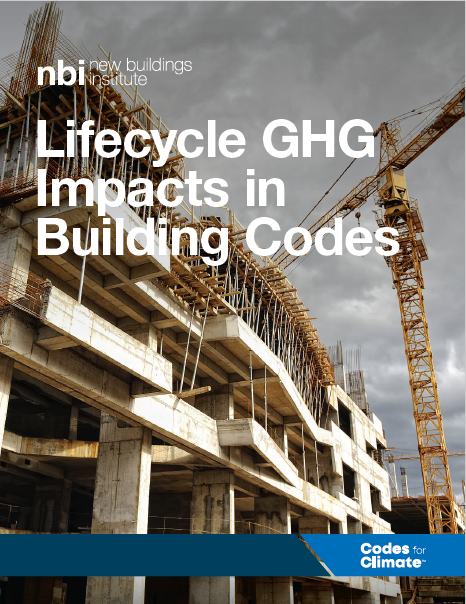
Lifecycle GHG Impacts in Building Codes
Report / January 18, 2022
NBI’s report presents language to incorporate embodied carbon requirements in building codes. Researchers explain the need to address the embodied carbon of the highest emitting materials and the carbon emission benefits for jurisdictions. This report examines the current lack of…
The Technical Basis of Building Performance Standards
Paper / March 19, 2021
As leading cities and states seek to meet their aggressive climate, energy, and decarbonization goals, they are turning increasingly to mandatory policies that require improved energy and emissions performance across their existing building stock. The most comprehensive of these policies…
Taking the (Fuel) Blinders off Energy Codes Part 2: Metrics and Mechanics in the Modern Era
Paper / March 26, 2020
This paper follows upon a recently published paper examining how climate policy now impacts energy code policy. A variety of drivers, including greenhouse gas emission goals, regulation, market forces, and new technologies, is changing the relationship between buildings and the…
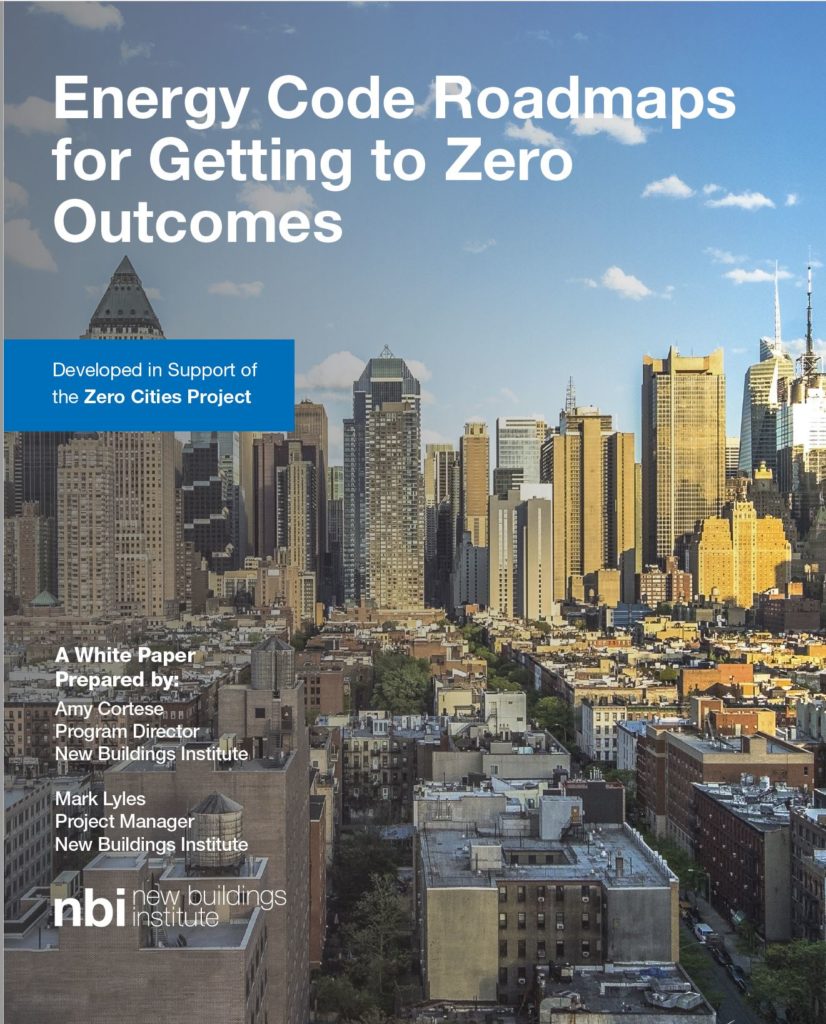
Energy Code Roadmaps for Getting to Zero Outcomes
Paper / February 20, 2020
Advanced energy codes are an important policy mechanism to advance energy efficiency and integrate renewables into the built environment. Energy code roadmaps lay the groundwork by identifying the order and priorities necessary for subsequent code improvements on the path to…
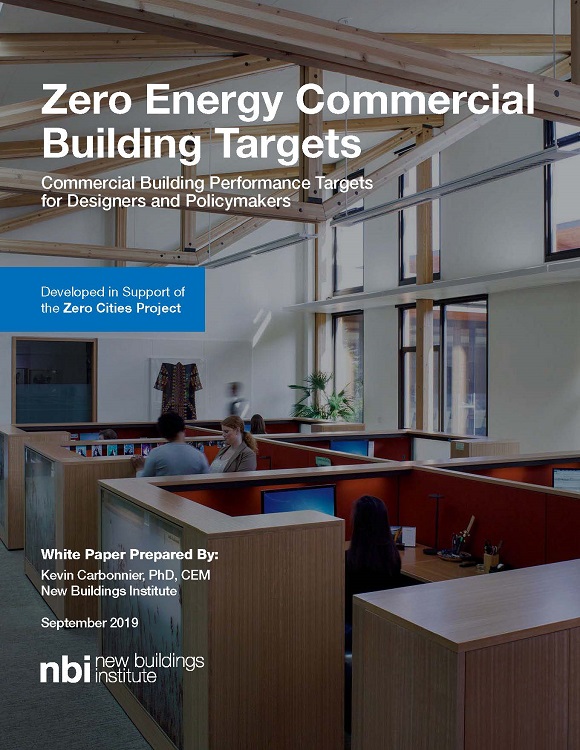
Zero Energy Commercial Building Targets
Paper / September 9, 2019
The critical first step in achieving a zero energy building is to set an energy use target. This Zero Energy Commercial Building Targets white paper helps define appropriate goals for these ultra-low energy buildings, which often surpass even the most…
Stretch Codes on the Road to Zero Energy – Potholes and Speed Traps Ahead
Paper / August 27, 2018
This paper details how a range of stretch code efforts, working in parallel, contribute to the overall progress in energy savings, with many current stretch codes targeting 20% energy savings from ASHRAE 90.1-2013/2015 IECC. It also explores how stretch codes…
Taking the (Fuel) Blinders off Energy Codes
Paper / August 27, 2018
Amidst a backdrop of the Arab Oil Embargo of 1973 and a perception of physical limits on energy resources, the obvious policy imperative of a new generation of energy codes was to reduce the use of all types of energy.…
Federal Preemption as a Barrier to Cost Savings and High Performance Buildings in Local Energy Codes
Paper / June 22, 2017
This white paper from New Buildings Institute (NBI) looks at the impacts of federal rules on efficiency standards for appliances, water heating and HVAC equipment and lays out possible solutions from an examination of policies from around the world. Decades-old…
Proposed Multifamily Building Section for the 2018 IECC
Document / October 16, 2015
NBI presented the first public “straw-man” of a proposed section for multifamily buildings in the 2018 International Energy Conservation Code (IECC) to the Department of Energy's Denver Energy Codes Stakeholder Meeting on October 13, 2015.
Washington State Energy Code Roadmap
Report / September 11, 2015
The purpose of this roadmap is to provide context for the policy and code performance goals for new buildings in Washington law and identify the mechanisms and cycles by which code provisions can evolve to meet these goals. These code…
Getting to Outcome-Based Building Performance Event Report
Report / May 6, 2015
This report summarizes the work undertaken by a group of building industry thought leaders who gathered for a Performance Outcome Summit in August 2014 in Seattle, Washington. During a day and a half workshop, the group examined the opportunities, barriers…
Essential 7: Commercial Energy Code Voting Guidance for the 2015 IECC-Comm
Document / October 1, 2013
New Buildings Institute, Northwest Energy Codes Group, Institute for Market Transformation and Southwest Energy Efficiency Project identified seven key issues to ensure that the 2015 IECC improves energy efficiency, is easier to apply, and makes compliance and enforcement more straightforward.…
Title 24 Final FDD Language and Explanation
Document / April 24, 2013
The language included in the California Title 24-2013 Energy Standards for Non-Residential Buildings requiring certain FDD features in all new rooftop unit heating and cooling equipment of 5-ton capacity or greater starting in 2014.
Utility Programs in a World of Rapid, Code-Induced Advancements in Energy Baselines
Paper / September 7, 2012
In recent years, model energy codes – which traditionally require the implementation of specific measures and strategies at the time of new commercial and residential construction – have set the stage for large increases in energy savings as states and…
White Paper on Establishing a Pathway to Outcome-Based Code Policy
Paper / May 16, 2012
For several years, NBI has been engaged in wide‐ranging conversations about code stringency increases and the degree to which current code strategies can continue to achieve aggressive efficiency goals that have been targeted. We have come to recognize that current…
Sensitivity Analysis: Comparing the Impact of Design, Operation, and Tenant Behavior on Building Energy Performance
Report / July 27, 2011
This study compares the magnitude of energy impact that various design features, operations and tenant behaviors have on total building energy use. The findings of this study can help the building community begin to align their priorities with those building…
Outcome-Based Energy Codes for Existing Buildings, Seattle Model Energy Code Project
Report / May 16, 2011
The Preservation Green Lab (PGL), the City of Seattle, and New Buildings Institute (NBI) are collaborating on a new energy code framework for existing and historic buildings that will pair accountability for actual performance outcomes with flexibility in how building…
Code Calibration: Understanding What Energy Codes Can Really Achieve
Paper / July 28, 2010
This paper observes that a key problem with current energy code practice is the difficulty in determining what level of performance the codes are delivering. Current energy code practice is based on estimated energy use of a theoretical sample of…
California Outdoor Lighting Baseline Assessment
Report / January 21, 2010
This is the first major study to provide real data about commercial building outdoor lighting in the State of California. The report identifies statewide outdoor lighting design practices; estimates energy demand and consumption; and provides a framework for outdoor lighting…
Summary and Recommendations of the Getting to 50 Summit
Report / January 21, 2010
In March 2007, New Buildings Institute (NBI) hosted and facilitated the Getting to 50 Summit. This meeting of 60 experts was initiated to develop relationships and strategies which will significantly and rapidly reduce energy use in new and renovated commercial…
Events
There are no events for Codes & Policies. Please see our other events below.
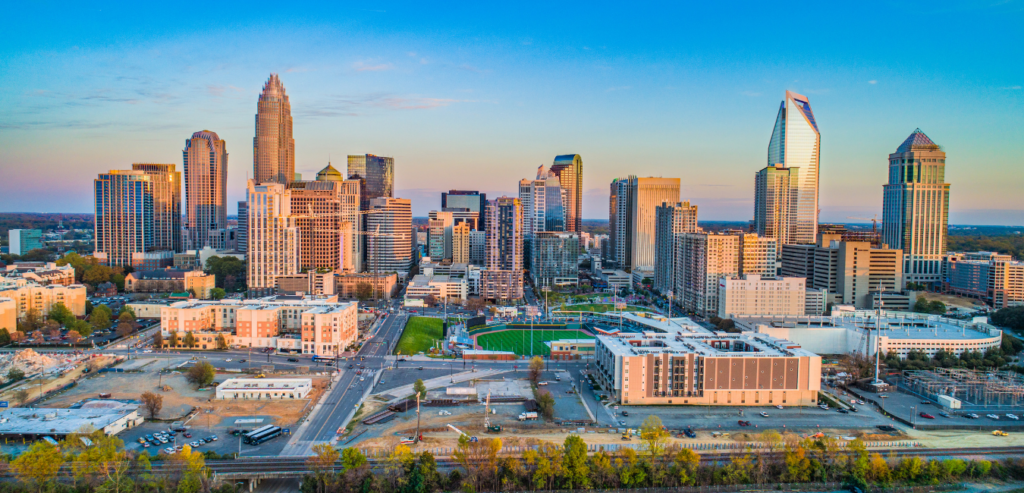
2024 Getting to Zero Forum
Event / May 21, 2024 - May 23, 2024
The Getting to Zero Forum is the premier event dedicated to building decarbonization. With a growing number of climate emergencies across the United States and around the world, there is no more important time than now for the Getting to…

Combi Heat Pump Webinar
Webinar / May 22, 2024 @ 10:00 am - 11:00 am PDT
This webinar will delve into combination space and water heating systems, also known as combi systems. While these systems seem promising, they present a level of complexity that raises questions about their practicality. The current market boasts standalone heat pump…
NewsView All
Illinois to Become Latest State to Release Its Own Stretch Energy Code
News / April 24, 2024
Published by Green Building Advisor: the state’s legislature voted last May to extend its adoption period by six months in response to concerns about how the stretch code might hold up against the upcoming 2024 IECC. Turns out this was a...
Fort Collins Paves the Way to a Sustainable Future with a DOE RECI Grant
News / April 24, 2024
Published by Building Safety Journal: Through collaborating with partners like the Florida Solar Energy Center and New Buildings Institute, the City of Fort Collins will work to analyze its current energy use to help determine energy targets.
10 things I know about… Sustainable development, part 1
News / April 24, 2024
Published by Worcester Business Journal: The City of Worcester pledged two years ago to become the nation’s greenest midsize city, and it may well achieve that goal. Worcester is one of only a few dozen midsized cities in the country...
California becomes the first state in the U.S. to tackle embodied carbon in its building codes
News / August 18, 2023
Published by The Architect’s Newspaper: The California Building Standards Commission (CBSC) and the Division of the State Architect (DSA) updated California’s building codes last week, putting into effect measures that set a new precedent in the United States. On August...
California Building Standards Commission Approves Landmark Embodied Carbon Requirement
News / August 9, 2023
California becomes the first state in the nation to require embodied carbon on buildings larger than 100,000 square feet. Sacramento, Calif.– In a unanimous decision, the California Building Standards Commission has passed two California Green Building Standards Code (CALGreen) amendments...
U.S. Department of Energy Awards Grants to Eight Projects Supported by International Code Council
News / July 27, 2023
Published by PHCP Pros: In a move to enhance energy efficiency and building resilience, the U.S. Department of Energy (DOE) announced plans to allocate $90 million in grants to aid the implementation of stronger building energy codes for new and...
POTOMAC: Schumer Vows Permitting-Reform Push
News / July 20, 2023
Published by Clearing Up: The Department of Energy on July 12 awarded $90 million in grants for updating building energy codes. Western grant recipients include the California Energy Commission; the City of Fort Collins, Colorado; the Colorado Energy Office; and...
DOE awards $90 million for adoption of latest building energy efficiency codes
News / July 13, 2023
Published by PV Magazine US: New Buildings Institute was among various states, cities, tribes and nonprofits that were awarded grants for activities that will support energy code updates and implementation, including workforce development, community engagement, research and data collection, energy,...
The urgency of cooling access: Ensuring resilience and promoting equity in the U.S.
News / June 14, 2023
Published by Refigeration Industry: Financial assistance programs can help low-income households purchase energy-efficient, climate-friendly cooling appliances (like efficient air conditioners or heat pumps) that cost less to operate due to reduced energy consumption. Similar programs can also provide low-income households with...
Codifying Wood Pellet Heating’s Renewable Bona Fides
News / May 17, 2023
Published by Biomass Magazine: Believing that “biomass” was far too broad, New Buildings Institute introduced new language to further clarify biomass and exclude wood and wood-derived fuels. Specifically, NBI suggested revised language changed “biomass” to “biomass waste” adding a definition...
4 Big Questions as Building Codes Consider Embodied Carbon
News / May 2, 2023
Published by BuildingGreen: The urgency of curbing embodied carbon, the greenhouse gas emissions associated with building materials, continues to escalate. Voluntary rating systems have been working away at the issue for more than a decade. “We know carbon emitted from...
Tackling the Job of Building Modernization: A Toolkit for State Decision-Makers
News / April 7, 2023
Published by RAP Online: New Buildings Institute assisted in the assemble of Building Modernization Legislative Toolkit, a resource for policymakers seeking to help move forward the energy transition in buildings. The toolkit takes a comprehensive look at key topic areas...
Biden Is Mysteriously Defying A Law That Could Spur 20,000 New Green Homes Per Month
News / March 28, 2023
Published by Huffington Post: The White House is required by law to move forward on a minor regulatory update that could have enormous consequences, spurring construction of tens of thousands of new homes built to the nation’s greenest energy efficiency standards...
New building codes to help industry reach net zero
News / March 17, 2023
Published by Build Australia: Australia’s latest efforts to reduce carbon emissions have culminated with the Green Building Council of Australia’s new Carbon Positive Roadmap for the built environment. The roadmap’s main goal is to reach net zero emissions by 2050....
Port writes the book on sustainability
News / March 2, 2023
Published by Camas-Washougal Post-Record: Port of Camas-Washougal officials have been promoting renewable energy sources lately — partnering with a county agency to install solar panels at its industrial park and taking the lead on installing electric vehicle chargers in East...
Can Our Homes Keep Up With Increasing Electrical Demands?
News / February 15, 2023
Published by Government Technology: New electric loads — like those brought about by electric vehicles and heat pumps — will likely force upgrades to home electric systems and building codes, experts say. The real challenge will be making changes consistently....
Podcast: Energy vs. Carbon – Jurisdictions and Utilities Align Metrics
News / February 14, 2023
In the fourth episode of our series of NBI staff discussing papers presented at the 2022 ACEEE Summer Study, we talk with NBI Senior Project Manager, Webly Bowles and Kim Cullinane of Eversource about the shift taking place within utility...
Climate and Construction: The challenges of addressing construction’s two-part carbon story
News / January 19, 2023
Published by DailyCommercialNews: Over the past 10 years, the importance of energy efficiency and the consequent reduction of GHG emissions from homes and buildings have gained increased attention from governments, the public and the construction industry. Globally, the New Building...
Targeting Net-Zero Emissions
News / January 6, 2023
This article was written by NBI President Emeritus, David Goldstein: Published by NRDC: Net -zero energy has attracted rapidly growing interest around the world. Growth rates of projected and verified zero-energy buildings are continuing to be high. This progress has...
Making a Federal Case for Greener Buildings
News / January 5, 2023
Published by EC&M: A move by the Biden administration to start the long process of electrifying federal buildings could be a watershed moment in the drive to reduce the carbon footprint of a top source of greenhouse gas emissions. In...
Podcast: New Construction From Codes to Net Zero
News / December 20, 2022
Continuing our series of NBI staff discussing papers presented at the 2022 ACEEE Summer Study, we talk with Senior Project Manager, Sean Denniston, about how NBI’s groundbreaking Building Decarbonization Code can be used by jurisdictions. Sean co-authored the paper Driving...
Codes for Climate December 2022 Newsletter
News / December 8, 2022
The latest Codes for Climate newsletter includes key updates on the process for both drafts of the 2024 Commercial and Residential International Energy Conservation Codes (IECC), codes and standards development updates, federal and state policy updates, federal funding opportunities for codes,...
In Challenge To Industry, White House Looks To Set ‘A New Gold Standard’ For Green Buildings
News / December 7, 2022
Published by HuffPost: Buildings use nearly half the United States’ energy ― and produce more than a third of the country’s climate-changing pollution, if you combine emissions from oil furnaces and gas stovetops with those from the electricity powering elements...
Podcast: The Intersection of Energy Codes and Building Performance Standards
News / December 2, 2022
In the first episode of a series of NBI staff discussing papers presented at the 2022 ACEEE Summer Study, we talk with NBI Director of Codes Kim Cheslak about the relationship between building codes and existing or proposed building performance...
Minneapolis offers incentives for EV chargers in new garages after state code blocks requirement
News / November 25, 2022
Published by News Pub: Attempting to sort out one of many greatest challenges within the shift to electrical automobiles — the dearth of at-home charging at flats and condos — the Metropolis of Minneapolis final yr required electrical automobiles chargers...
Buy Clean: A First Step in Low-Carbon Standards
News / November 17, 2022
Published by Green Building Advisor: The federal government is ramping up efforts to cut greenhouse gas emissions with the Federal Buy Clean Initiative, a plan to use the government’s enormous buying power to force wider use of low-carbon building materials....
New Buildings Institute Introduces a Building Decarbonization Model Code
News / November 9, 2022
Published by Zondits: Expanding its focus on advanced building energy codes, New Buildings Institute (NBI) has announced the release of a new model code with a focus on decarbonizing the U.S. residential and commercial building stocks. Model codes are intended...
Organizations Seek Governmental Support in Lowering Building Emissions
News / November 9, 2022
Published by Environment + Energy Leader: Two dozen building organizations are calling on government representatives at COP27 to commit to decarbonization efforts in the built environment, which they say is a leading driver of climate impacts. The group of building...
Codes for Climate Early November 2022 Newsletter
News / November 4, 2022
The latest Codes for Climate newsletter includes info on the draft 2024 Commercial and Residential International Energy Conservation Codes (IECC), a webinar explaining how to submit public comments on the Residential draft, federal funding opportunites, codes and standards development updates, news,...
Why Building Energy Codes Are Gaining Traction
News / September 29, 2022
Published by EC&M: The International Energy Conservation Code (IECC), is in the latter stages of its triennial revision and could ultimately incorporate requirements that widen the code’s scope from simply energy savings and efficiency to include aggressive decarbonization strategies. Proposals...
Washington, DC, poised to ban natural gas use in new buildings
News / September 28, 2022
Published by S&P Global: Washington, D.C., could become the latest East Coast city to prohibit natural gas use in new homes and commercial buildings if a divisive all-electric construction mandate survives an upcoming vote. Many cities and states update their building codes...
A game-changing model code for existing buildings gives jurisdictions a path to eliminate carbon emissions in the current building stock
News / September 19, 2022
The Existing Buildings Decarbonization Code is an overlay to the 2021 International Energy Conservation Code (IECC) and covers residential and commercial retrofits New Buildings Institute (NBI) has released the Existing Building Decarbonization Code, a new way for jurisdictions to reduce...
International Code Council Honors Building Safety Professionals with 2022 Awards
News / September 13, 2022
These distinguished individuals and organizations are being recognized for their exemplary work and service to their communities, the building safety industry, and the Code Council Louisville, K.Y. – During its 2022 Annual Conference in Louisville, Kentucky, the International Code Council recognized...
Twenty-Six Health and Climate Organizations Call on EPA to Limit Pollution from Fossil Fuel-Fired Household Appliances
News / August 23, 2022
Fossil fuel appliances are a significant contributor to smog, petition alleges the lack of standard Twenty-six health, environmental, and consumer protection groups (full list below) formally petitioned the Environmental Protection Agency (EPA) today to protect public health from dangerous outdoor...
Historic Inflation Reduction Act becomes law; industry celebrates
News / August 16, 2022
45 organizations welcome investments as a turning point to combat climate change and build clean energy future WASHINGTON, D.C.—Amid a rapidly warming climate, President Biden today signed the Inflation Reduction Act into law. The nonpartisan Committee for a Responsible Federal...
Over 60 organizations celebrate introduction of historic climate provisions in Inflation Reduction Act, call for its swift passage to address climate emergency, lower household energy costs
News / August 4, 2022
WASHINGTON, D.C.—Key Democratic leaders have struck a historic deal to lower energy bills and address the climate crisis with the introduction of the Inflation Reduction Act of 2022 – which aims to reduce carbon emissions by roughly 40% by 2030...
What You Need to Know About Building Performance Standards
News / July 29, 2022
Published by FacilitiesNet: Building performance standards are the latest tool being used by state and local governments to reduce energy use and greenhouse gas emissions in existing buildings. We talked to two noted building performance standard experts, Kimberly Cheslak, director...
Codes for Climate July 2022 Newsletter
News / July 28, 2022
The latest Codes for Climate newsletter includes info on the initiative’s one year anniversary, recent codes and standards development updates, federal, state and local action updates, recent news, upcoming events, and more. Learn more by reading the full newsletter.
DC to Ban Gas in Most New Buildings
News / July 27, 2022
Published by PaintSquare: The Council of the District of Columbia joined several other major cities in the nation through the unanimous passing of two new pieces of legislation requiring that all new buildings and substantial renovations in Washington D.C. be...
Climate change prompts a push away from natural gas
News / July 18, 2022
Published by Everett Herald: While the gas industry describes heat pumps as “not a silver bullet,” many do consider them a major weapon in the battle to reduce greenhouse gas emissions. Heat pumps not only provide efficient space heating but...
Groups Urge Michigan To Adopt New Building Rules For Energy Efficient Homes, Businesses
News / July 7, 2022
Publiched by Michigan Business Network: Building more energy-efficient homes and businesses across Michigan is cost-effective, will improve the health and safety of Michigan residents, and create new jobs, a group of industry, health, and environmental organizations said today. The organizations...
Codes for Climate June 2022 Newsletter
News / June 28, 2022
The latest Codes for Climate newsletter includes info about recent codes and standards development updates, including a number of proposals that will improve the efficiency of existing buildings, federal, state and local action updates, recent news, upcoming events, and more. Learn...
Proposed Building Decarbonization Bill Would Help Electrify the County’s Future
News / June 14, 2022
Published by MyGreenMontgomery.org: “We’re entering a new era of building design and construction that will bring our ambitious climate goals to life,” opened Lindsey Shaw, Chief of the Energy and Climate Section of the Montgomery County Department of Environmental Protection,...
Natural gas legislation: What multifamily developers, owners need to know
News / June 2, 2022
Published by Constructive Dive: Bans on natural gas hookups in new buildings are spreading across the country. In 2019, Berkeley, California, was the first city to ban natural gas hookups in new buildings. So far, 77 cities in 10 states...
Contract-laden GSA calls for concrete, asphalt EPD submittals
News / May 31, 2022
Published by Concrete Products: A new U.S. General Services Administration standard targeting low embodied concrete on federal projects will require contractors to provide environmental product declarations (EPD), where available, from ready mixed suppliers. It compels procurement of concrete exhibiting production...
Podcast: The Cost of Building Decarbonization
News / May 18, 2022
Peggy and Kim Cheslak, Director of codes at New Buildings Institute, discuss a new study on building decarbonization. She says one of the primary questions is: what does it cost? Thus, it went into the study with two primary goals:...
Hochul Admin. Presses for Immediate Action on All-Electric New Construction at Hearing
News / May 12, 2022
Published by Food & Water Watch: Today, the Assembly hearing on the All-Electric Building Act is demonstrating the consensus that ending gas in new construction fights climate change, creates jobs and cuts air pollution. Experts, including NYSERDA President Doreen Harris...
Cheaper to electrify US homes during construction than after
News / May 10, 2022
Published by Energy Monitor: It is cheaper to electrify buildings – or at least make them ready for future electrification – at the time of construction than retrofitting them for electric equipment afterwards, according to new research from US non-profit New Buildings Institute...
NBI Releases Cost Study of the Building Decarbonization Code
News / April 27, 2022
Published by EC&M: New Buildings Institute (NBI) recently released the “Cost Study of the Building Decarbonization Code.” The study analyzes the incremental first cost and life cycle cost of two common building types that follow the code language in NBI’s...
Washington state to require electric heating in building code update
News / April 25, 2022
Published by S&P Global: Washington will require all-electric space and water heating in new commercial and multifamily construction, making it the first state to incorporate building electrification mandates into statewide energy codes. One proposal would require all-electric systems and appliances...
Codes for Climate: A Vehicle for Change
News / April 25, 2022
Published by MTBA Architecture: One of the biggest obstacles for deep green retrofits to existing & historic spaces is the lack of regulations and building codes that enforce climate goals. The opportunity to create new building codes for climate is...
Report spells code-geared carbon benchmarks
News / April 19, 2022
Published by Concrete Products: The most recent New Buildings Institute (NBI) report presents language to incorporate embodied carbon requirements in codes, and explains the need for jurisdictions to address such criteria for materials or products with the highest carbon dioxide...
Demystifying Energy Code Development
News / April 18, 2022
Published by NRDC: Historically, the energy code has been developed through a public process where stakeholders submit proposed changes to the code, then come together to debate the proposals in front of a technical committee that makes recommendations for whether...
Building contract-rich GSA to require concrete, asphalt EPD submittals
News / April 11, 2022
Published by Concrete Products: A new General Services Administration standard targeting low embodied concrete on federal projects will require contractors to provide environmental product declarations (EPD), where available, from ready mixed or precast suppliers. It compels procurement of concrete exhibiting...
Embodied Carbon Limits: New Language for Codes and Specs
News / April 7, 2022
Published by BuildingGreen: Aspirational limits on embodied carbon in our buildings are all well and good, but how do you actually determine and implement those limits? New code language and a new model specification could be the ticket. New Buildings...
Biden Administration Takes Important Step In Buying Clean
News / April 6, 2022
Published by Natural Resources Defense Council: The Biden Administration has taken an important step forward in leveraging the purchasing power of the federal government to grow the market for cleaner industrial materials. For the first time, the Government Services Administration...
Government Sets Carbon Limits on Concrete for Federal Projects
News / March 31, 2022
Published by Scientific American: The procurement arm of the federal government is imposing new limitations on high carbon-emitting building materials for all its major projects, a move that will affect billions of dollars of federal infrastructure investments. GSA only will...
Why the Natural Gas Industry Wants to Make Sure You Never Get an Electric Car
News / March 8, 2022
Published by Slate: After failing to overturn an election expected to hasten the transition away from fossil fuels, conservative industry groups last year managed to get future votes canceled and tightened their grip over the process used to develop new...
A Battle Over Building Codes May Be The Most Important Climate Fight You’ve Never Heard Of
News / March 3, 2022
Published by The Huffington Post: After failing to overturn an election expected to hasten the transition away from fossil fuels, conservative industry groups last year managed to get future votes canceled and tightened their grip over the process used to...
Energy Standards To Perform
News / February 23, 2022
Published by Facility Executive: This past January, President Biden announced the establishment of a Buildings Performance Standards Coalition during remarks at the U.S. Conference of Mayors winter meeting. The announcement highlighted the importance of enacting policy to support emission reductions...
Report gauges building codes’ impact on embodied carbon in project specs
News / February 22, 2022
Published by Concrete Products: The most recent New Buildings Institute (NBI) report presents language to incorporate embodied carbon requirements in codes, and explains the need for jurisdictions to address such criteria for materials or products with the highest carbon dioxide...
A New Coalition Takes Aim at Emissions from Existing Buildings
News / February 1, 2022
Published by Architectural Record: At the United States Conference of Mayors winter meeting, held earlier this month in Washington, D.C., President Biden announced a new collaboration with state and local governments to reduce carbon emissions from the built environment. Known...
Unions, Industry, Environmental Leaders, and Elected Officials Agree New Building Performance Standards Coalition Will Deliver
News / January 25, 2022
Published by The White House: Last week, President Biden announced during his remarks at the U.S. Conference of Mayors that his Administration is teaming up with states, cities, labor, and industry to launch the Building Performance Standards Coalition, a first-of-its-kind partnership between 33 state and...
White House forms coalition with local governments to pursue building performance policies
News / January 24, 2022
Published by Smart Cities Dive: President Joe Biden on Friday announced the launch of a Building Performance Standards Coalition, a partnership between more than 30 city and county governments along with the states of Colorado and Washington. The announcement came during...
Commentary: It’s time for Delaware to act on climate change
News / January 21, 2022
Published by Bay to Bay News: Please join us in urging the elected officials at all levels to take prompt legislative and administrative actions at the systemic level to reduce the risks to life and property in Delaware from declining biodiversity,...
The Biggest Issues to Watch in 2022
News / January 20, 2022
Published by Governing: State legislatures will have a lot on their plates. They’ll deal with issues in wildly differing ways. This article sets the context for the 2022 session with an overview of everything from abortion to taxes. Kim Chelsak,...
Maryland Green Buildings Bill To Be Based on Commission Report
News / December 20, 2021
Published by RTO Insider: Commercial and multifamily residential buildings in Maryland would be required to eliminate their carbon emissions and new buildings would be all-electric under a bill being drafted in the state’s House of Delegates. And ideas in the...
How New Buildings Institute is Pushing CRE Toward Net Zero Carbon
News / December 9, 2021
Published by Leverage.com: One of the key teams that are helping the building sector get to zero is New Buildings Institute. This nonprofit organization sits at a peculiar intersection in the building world, as they help improve the energy performance...
Denver plans to send large buildings into the warm embrace of renewable electricity
News / November 24, 2021
Published by Denverite: In its latest attempt to fight climate change, Denver City Council unanimously approved a new ordinance to supercharge the city’s big buildings. The city crafted the ordinance alongside New Buildings Institute, a Portland-based advocacy group that keeps...
Maps: How State Energy Codes Compare to Efficiency Goals
News / November 18, 2021
Published by Governing: Building energy use accounts for nearly 30 percent of total greenhouse gas emissions. The latest energy codes can reduce carbon dioxide, but many states continue to use standards that are outdated. Kim Cheslak, director of codes for...
Building codes are wonky and dense. But they can slash emissions and pollutants.
News / October 13, 2021
Published by Grist: States and cities across the country are revamping often arcane building codes to limit the use of fossil fuels in homes and workplaces. It’s an essential shift, as gas-powered appliances like furnaces and water heaters are a...
NBI Releases Code Overlay for Electrification
News / October 4, 2021
Published by BuildingGreen: New Buildings Institute (NBI) wants to help jurisdictions bite off however much electrification they can chew. Recently released model code language offers provisions for requiring all-electric buildings and alternative provisions for requiring electric-ready buildings. Cities and towns can layer...
DOE stirs up climate fight over building codes
News / September 21, 2021
Published by E&E News: Energy Secretary Jennifer Granholm warned the creators of the nation’s most widely used model for building energy codes yesterday that their work could be sliding toward “irrelevance” in addressing climate change, signaling that a once-obscure policy...
Cracking the Code
News / September 8, 2021
Published by Architect Magazine: Building codes and regulations shape our cities in countless ways, distilling generations of development experience, best practices for safety, technological know-how, and, especially in the case of zoning laws, society’s harmful, retrograde views on equity and equality....
California Forging Ahead on Zero Emission Buildings
News / August 12, 2021
Published by NRDC: Hopeful climate news came from Sacramento, CA as the California Energy Commission (CEC) took a major stride toward zero-carbon emissions buildings in the 2022 update of the statewide building energy code it just adopted. Energy use in...
Decentralized approach to codes means emissions reduction responsibility falls on local officials
News / August 11, 2021
Published by Building Design & Construction: While organizations such as the International Code Council set energy efficiency standards, in the U.S., state and local governments have the responsibility of adopting their own building codes. In Minnesota, for instance, a coalition of...
California takes bold steps to make electricity the fuel of choice for new buildings
News / August 11, 2021
Published by Canary Media: California has become the first state in the U.S. to pass building codes to make all-electric heating and appliances the default choice for newly built homes. It’s a win for advocates of limiting natural gas use...
The Fight to Change US Building Codes
News / August 2, 2021
Published by Inside Climate News: Energy consumed in buildings produced more than 30 percent of U.S. greenhouse gas emissions in 2019, making them a key part of the climate challenge. And the window to decarbonize them is narrowing: Analysts at organizations such...
How to Reduce Building Emissions and Center Equity: A New Framework for Policymakers and Communities
News / July 20, 2021
Framework co-developed with cities shows how Building Performance Standards can address city climate priorities and aid in promoting equitable economic recovery To support efforts to reduce energy use and greenhouse gas emissions from existing buildings, eight organizations came together with...
Buildings are big polluters: here’s the path to their decarbonisation.
News / July 8, 2021
Published by Smart Energy International: Buildings account for 39% of all the carbon emissions in the US, more than any other sector. According to the US Green Building Council, the emissions of US buildings alone are more than those of...
With Time Running Out To Cut Carbon From Buildings, Industry Just Tightened Its Grip
News / July 1, 2021
Published by Huffington Post: Buildings are huge generators of planet-warming gases, with fossil fuels responsible for everything from heating and cooling to cooking and charging our devices. Experts say a massive overhaul of building efficiency is imperative within the next...
Codes for Climate Offers States and Cities a Path to Building Decarbonization
News / June 25, 2021
Published by North American Clean Energy: As states and cities seek to fulfill their climate goals, it’s not clear that national code-making entities will keep pace with the efficiency stringency and building decarbonization measures that are necessary. Buildings currently represent...
New Stretch Code Will Mean Low-Carbon Buildings
News / May 16, 2021
Published by Green Lodging News: Transitioning America’s buildings away from burning fossil fuels for heating and water heating, toward equipment powered by increasingly clean electricity is key to meeting the nation’s climate goals, including President Biden’s commitment to net-zero carbon...
Code Council ushers new voices into building energy efficiency dialog
News / April 28, 2021
Published by Concrete Products: A new International Code Council framework will assist governments and building industry stakeholders in meeting energy efficiency and greenhouse gas reduction goals. The Code Council Board of Directors, which consists of 18 government officials who were...
Commercial buildings: an EV-ready approach for new builds and retrofits
News / April 20, 2021
Published by Electric Autonomy: In the third article in a series that explores how to make the built environment EV-ready, Brendan McEwen turns to commercial buildings, outlining how building codes and assessing user needs can achieve EV-ready outcomes. The New...
US building codes need a major retrofit to meet climate goals and spare consumers
News / April 7, 2021
Published by Smart Cities Dive: The International Code Council, which rolled back local governments’ say in energy efficiency regs for buildings, needs to adapt to the times or step aside, writes Energy Innovation’s Sara Baldwin. Buildings generate around a third...
ICC Makes Controversial Change
News / March 19, 2021
Published by Architectural Record: Early in March, the board of directors of the International Code Council (ICC) moved to overhaul the process for developing its model energy code. The controversial change entails switching from a framework in which thousands of...
Changes to Energy Code Process Strip Power from Local Voters
News / March 9, 2021
Published by NRDC Expert Blog: The organization that administers the process for developing the national model building energy code for new homes and other buildings used by cities and towns nationwide has decided to make substantial changes to how it...
Industry organizations react to new ICC framework
News / March 8, 2021
Published by The Construction Specifier: A number of industry organizations have voiced their reactions to a new framework announced by the International Code Council (ICC). In reaction, New Buildings Institute (NBI) released a statement voicing is opposition the changes, which...
Overhaul of building energy code deals setback to gas ban backers
News / March 8, 2021
Published by S&P Global: The council responsible for developing model building codes overhauled its process for setting minimum energy efficiency requirements, blocking a pathway that local governments have used to secure decarbonization measures like building electrification and electric vehicle charging....
Code Fights
News / March 6, 2021
Published by POLITICO Morning Energy: The International Code Council meets today on whether to follow through on changing how energy conservation building codes are crafted. The changes would decrease input from local governments, which have previously pushed for aggressively greener...
New ICC framework sidelines local government participation in energy code development
News / March 4, 2021
NBI strongly opposes changes, which make action on climate “non-mandatory” The International Code Council (ICC) announced today a new framework that changes the essential nature of the International Energy Conservation Code (IECC) development process from a model energy code to...
New Stretch Code Will Mean Low-Carbon Buildings
News / February 25, 2021
Published by NRDC Expert Blog: Transitioning America’s buildings away from burning fossil fuels for heating and water heating, toward equipment powered by increasingly clean electricity is key to meeting the nation’s climate goals, including President Biden’s commitment to net-zero carbon...
Institute scribes Energy Conservation Code language for net-zero buildings
News / February 15, 2021
Published by Concrete Products: The New Buildings Institute presents its just-released Building Decarbonization Code as a groundbreaking tool for delivering carbon neutral performance and 2021 International Energy Conservation Code (IECC) overlay. NBI aims to help states and cities working to...
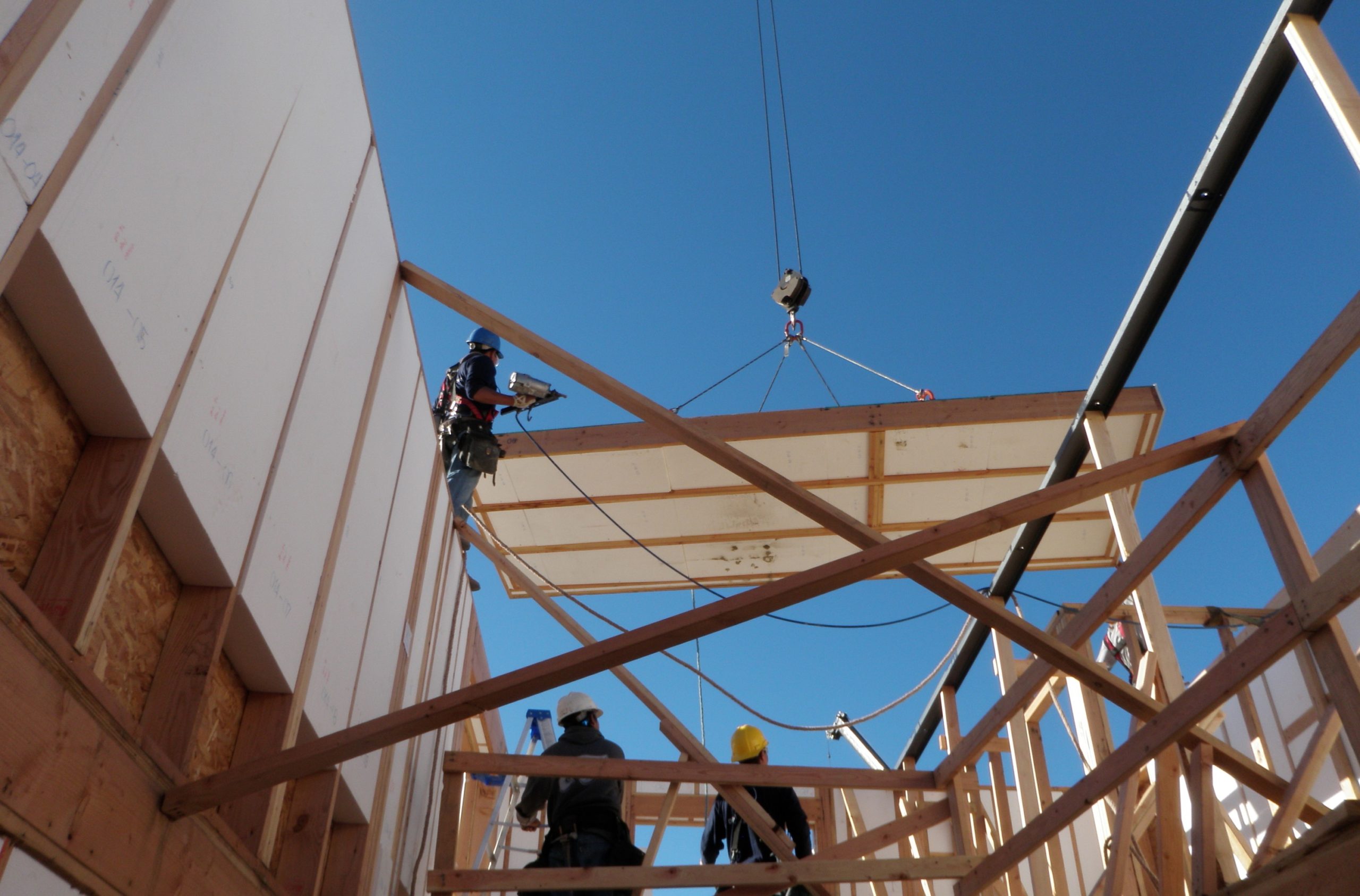
NBI releases code language that achieves carbon neutral buildings
News / February 11, 2021
The new Building Decarbonization Code works as an overlay to the 2021 IECC for residential and commercial construction projects. New Buildings Institute (NBI) released today new code language that serves as a building decarbonization overlay to the 2021 International Energy...
North Carolina panel moves to weaken building energy conservation rules
News / January 7, 2021
Published by Energy News Network: A change to North Carolina’s building code would let developers skimp on insulation and other energy-saving basics in exchange for flashier elements such as solar panels and super-efficient appliances. It highlights the role developers are...
What Architects Need to Know About IECC 2021
News / November 20, 2020
Published by Architect Magazine: By the end of this year, the latest edition of the International Energy Conservation Code will be available. Updated every three years, the IECC is designed to assist state and local governments to regulate energy use...
EVs dealt major blow in building code ruling
News / October 22, 2020
Published by Energywire: In a setback to clean energy advocates, gas industry and homebuilder associations blocked an effort this month to prepare new homes and commercial buildings for a future wave of electric vehicles, stoves and heaters. “There’s going to...
Inside the climate battle quietly raging about US homes
News / October 14, 2020
Published by The Guardian: Some challenges to US climate action are obvious. But many more play out behind the scenes. One of those is the battle over efforts to make America’s new homes and buildings more energy-efficient. On one side...
Fierce Fight Over Model Building Codes Nears Final Round
News / August 28, 2020
Published by Energywire: Natural gas interests and housing developers will mount a last-ditch effort next week to prevent U.S. model building codes from including new provisions to promote the electrification of cars, stoves and water heating. Though voluntary and little...
New Energy Code Is More Robust and Flexible than Previous Versions
News / February 25, 2020
Published by Engineering News-Record: The new International Energy Conservation Code (IECC), expected to be ready for adoption later this year, provides both residential and commercial builders more flexibility in making their projects more energy efficient and for the first time...
This Year’s Model: Key Standard Advances
News / February 21, 2020
Published by Commercial Property Executive: One of the most influential documents for energy practices is on track for its next upgrade. The International Energy Conservation Code, widely used by public agencies as a model for building performance, has been received...
Getting to zero carbon buildings requires zero carbon codes
News / January 30, 2020
Published by Foresight: Two-thirds of countries do not have energy building codes. This needs to change if buildings are to become part of the solution to the climate crisis, argues Jim Edelson, Director of Codes and Policy at New Buildings...
2021 Energy Code sets table for double-digit efficiency gains
News / January 20, 2020
Published by Concrete News: Approved 2021 International Energy Conservation Code ballot items will bring an estimated 10 percent or greater efficiency improvement for residential and commercial building envelopes in jurisdictions abiding the code. IECC changes will lower building energy use...
All New Homes Should be EV-Ready, Says International Code Council
News / January 17, 2020
Published by The Driven: The leading international organisation for building codes and standards says that all newly constructed homes should be EV-ready, and guidelines have been recently accepted by US local governments to ensure electric vehicles (EVs) are taken into...
US local governments vote in favour of new 2021 buildings efficiency code
News / January 9, 2020
Published by Smart Energy International: New Buildings Institute has announced that US local governments have voted in favour of the new 2021 International Energy Conservation Code (IECC). The new standard is expected to bring an estimated 10% more efficiency improvement...
Local Governments Vote Resoundingly for Improved Efficiency in National Model Energy Code
News / January 6, 2020
Voting results on the 2021 International Energy Conservation Code (IECC) are in, and the approved proposals will bring an estimated 10% or more efficiency improvement for both residential and commercial buildings that follow the IECC. These changes will lower building...
ASHRAE 90.1 Update Pushes Building Efficiency Above and Beyond
News / November 6, 2019
Published by facilitiesnet: For the first time ever, ASHRAE 90.1 will require commissioning. With about 100 other updates from the 2016 version, ANSI/ASHRAE/IES Standard 90.1-2019, Energy Efficiency Standard for Buildings Except Low-Rise Residential Buildings, has a reinvigorated focus on exceeding...
Code Officials: Here’s Your Chance to Be a Climate Hero
News / October 24, 2019
Published by NRDC: Buildings are responsible for about 40 percent of U.S. carbon emissions, and once built, they last a long time—60 to 100 years or more. To solve the climate crisis, we need buildings to use far less energy...
San José Adopts Strongest Building Code Among Large Cities
News / September 18, 2019
Published by NRDC: San José has successfully reached for a modern, more sustainable building energy code; its City Council voted to adopt requirements for builders that will provide San José residents with clean, affordable energy in buildings and make good...
How Cities Can Improve Homes
News / September 5, 2019
Published by GreenBiz: The way we use energy makes a big difference in our lives in how safe, comfortable and productive we are. In addition to impacting our individual lives, energy use in homes makes up a large part of...
IECC Committee Approves EV Charging Proposal
News / May 25, 2019
Published by Facility Executive Magazine: During the first week of May 2019, International Code Council (ICC) code hearings were held in Albuquerque, NM to determine which of the proposed code amendments will be considered for adoption in the 2021 model...
Energy Code Development Begins: Focus on Residential
News / May 23, 2019
Published by NRDC: Code officials, builders, energy efficiency advocates, and others weighed in this month on proposals to update the next model building energy code. NRDC and many others submitted proposals to the International Code Council back in January, offering...
It’s Time to Update the Energy Code to the Best One Yet
News / February 14, 2019
Published by NRDC: Building energy codes set minimum energy efficiency requirements for new and renovated residential and commercial buildings, which means buildings meeting the most updated code versions use even less energy to keep the lights on and their inhabitants...
RESTalk Interview with Eric Makela
News / October 22, 2018
Eric Makela, Associate Director, takes us on a journey through energy codes in a RESTalk interview. Learn how HERS raters influence the development of the IECC and more. Eric is the perfect tour guide, as he has spent the last...
What Will It Take to Make Buildings Carbon Neutral?
News / September 14, 2018
Published by CityLab: Last month, 19 cities signed a declaration to make all new buildings carbon neutral by 2030. So what happens next? If cities are going to curb the rise of global temperatures to less than 2 degrees Celsius,...
The Push and Pull of Building Performance
News / March 1, 2018
Published by Metal Architecture: Energy codes are often thought of as bringing up the rear, preventing the worst from happening, but not as drivers of innovation. Randy Croxton, FAIA is famously quoted for his astute observation, “Building to code means...
Stretch Codes Emerge as a High Impact Strategy for Energy Savings
News / February 26, 2018
Published by BuildingEnergy Magazine: For decades, local energy codes have defined the least efficient structure that could be legally built. Although codes have become stricter, they still fall short of industry experts’ recommendations toward zero-net energy. For projects that cannot...
A New Metric for Tracking Net-Zero Energy Codes
News / December 15, 2017
Published in Green Energy Times (pages 26 & 27): ACEEE’s 2017 State Energy Efficiency Scorecard was released in late September with Massachusetts leading based on six categories including utility programs, transportation, building energy codes, combined heat and power, state initiative...
NBI Stretch Code a Tool for Accelerating Efficiency Standards
News / November 15, 2017
Published in Building Design + Construction: The 20% Stretch Code, a new set of standards developed by New Buildings Institute (NBI), offers a tool for accelerating the use of more energy efficient designs in new buildings.

Could Stretch Codes Supercharge the Green Building Marketplace
News / November 10, 2017
Published in GreenBiz: Stretch codes are a promising solution that jurisdictions can use to drive better energy performance in the built environment and set a long-term vision for efficiency stringency in buildings further into the future. NBI released a model...
See How Local Building Codes Can Update Their Energy Requirements to be More Performance-Oriented, and How FMs May Need to Help Prove Compliance
News / November 7, 2017
Published in FMLink: A number of cities and states across the United States have begun to recognize that the current code-based mechanisms in place do not provide the means to help them achieve their energy performance goals for buildings, according...
New Stretch Code Measures Help Cities & States Fast-Track Building Energy Savings
News / November 6, 2017
With increasing pressure to deliver on energy and climate action goals, cities and states are turning to more stringent building energy codes as an effective strategy to increase building energy efficiency and accelerate progress on outcomes. By adopting forward-looking stretch...
NIBS, NBI Issue Guidance To Help Cities Achieve Energy Goals
News / November 1, 2017
Published in Facility Executive: New guidance document provides jurisdictions with a new approach to shift the focus towards buildings’ actual, measurable energy results.
NIBS, NBI Issue Guidance to Help Jurisdictions Achieve Energy Goals
News / November 1, 2017
Outcome-Based Path for Codes Focuses on Results, Looks at Building’s Actual Performance A number of cities and states across the United States have begun to recognize that the current code-based mechanisms in place do not provide the means to help...
The Federal Preemption Bind on Local Energy Policy
News / October 23, 2017
Published in Construction Executive: When it comes to energy efficiency in buildings, rapid technological advances are being undermined by outdated regulations. Decades-old federal laws currently prohibit states from setting energy standards for some of the most modern appliances, including heating...
Implications of Developments in National Model Codes for Historic Preservation
News / September 1, 2017
Published in the Alliance Review, a Quarterly Journal of the National Alliance of Preservation Commissions: Sean Denniston, Senior Project Manager, provides an overview of the impact of the model energy code on historic resources. Many historic buildings are inherently energy...
Going Green? Not So Fast, According to Federal Rule Structure
News / June 29, 2017
Published in Snips Magazine Blog: Ralph DiNola, CEO of New Buildings Institute, recently told me about a decades-old bump in the road: federal preemption rules. The organization outlined this setback in its recent white paper, “Federal Preemption as a Barrier to...
Local Energy Codes Hindered by Preemption Rules
News / June 22, 2017
White paper examines how the federal rule structure for appliances and HVAC equipment raise costs and limit improved energy performance Portland, OR—A white paper released today by New Buildings Institute (NBI) finds that federal preemption rules present a major barrier...
Forecasting Energy Policy in 2017: Energy Efficiency Still a Major Opportunity for FMs
News / March 23, 2017
Jim Edelson, Director of Codes and Policy, is quoted in this article from facilitiesnet. This is the first of a four-part cover story, looking at how the current administration policy may affect energy policy for the road ahead. Moves in federal...
The State of Technology: Outcome-Based Energy Codes and zEPI
News / August 1, 2016 / Energy Codes
This article focuses on two innovations in development over the last decade in energy codes: outcome-based energy codes and zEPI. It also features a graphic from New Buildings Institute’s “Energy Performance of LEED for New Construction Buildings”, which highlights how...
Institute Submits Outcome-Based Pathway for Inclusion in the 2018 IECC
News / April 5, 2016 / Energy Codes
Building on a multi-year, industry-wide effort to include an outcome-based pathway for energy compliance into the 2015 International Green Construction Code (IgCC), the National Institute of Building Sciences has introduced a similar proposal to be considered for inclusion in the...
What will energy codes look like in 2020?
News / October 29, 2015
Green building standards are influencing residential energy code, and vice versa. In this article published by Propane Jim Edelson, director of codes and policy at NBI, stated “It is likely that there will be a time in the next few...
IgCC Opens Compliance Pathway Based on Actual Energy Use
News / January 4, 2015
An outcome-based approach assures that buildings actually achieve energy targets, while relieving technical pressures on code departments, reported Environmental Business News. The 2015 International Green Construction Code (IgCC) will have a compliance option based on an outcome-based approach, officials announced...
Provisions adopted into the 2015 IgCC can assist progressive communities meet energy goals
News / December 2, 2014
Cities and states looking at energy efficient buildings to help meet energy goals are getting a boost from the 2015 International Green Construction Code (IgCC), reported RealEstateRama. Four critical proposals that will drive significant improvements in building energy performance were...
New 2015 IgCC can assist progressive communities to meet energy goals
News / November 25, 2014
November 24, 2014–Cities and states looking at energy efficient buildings to help meet energy goals are getting a boost from the 2015 International Green Construction Code (IgCC). Four critical proposals that will drive significant improvements in building energy performance were...
Blog
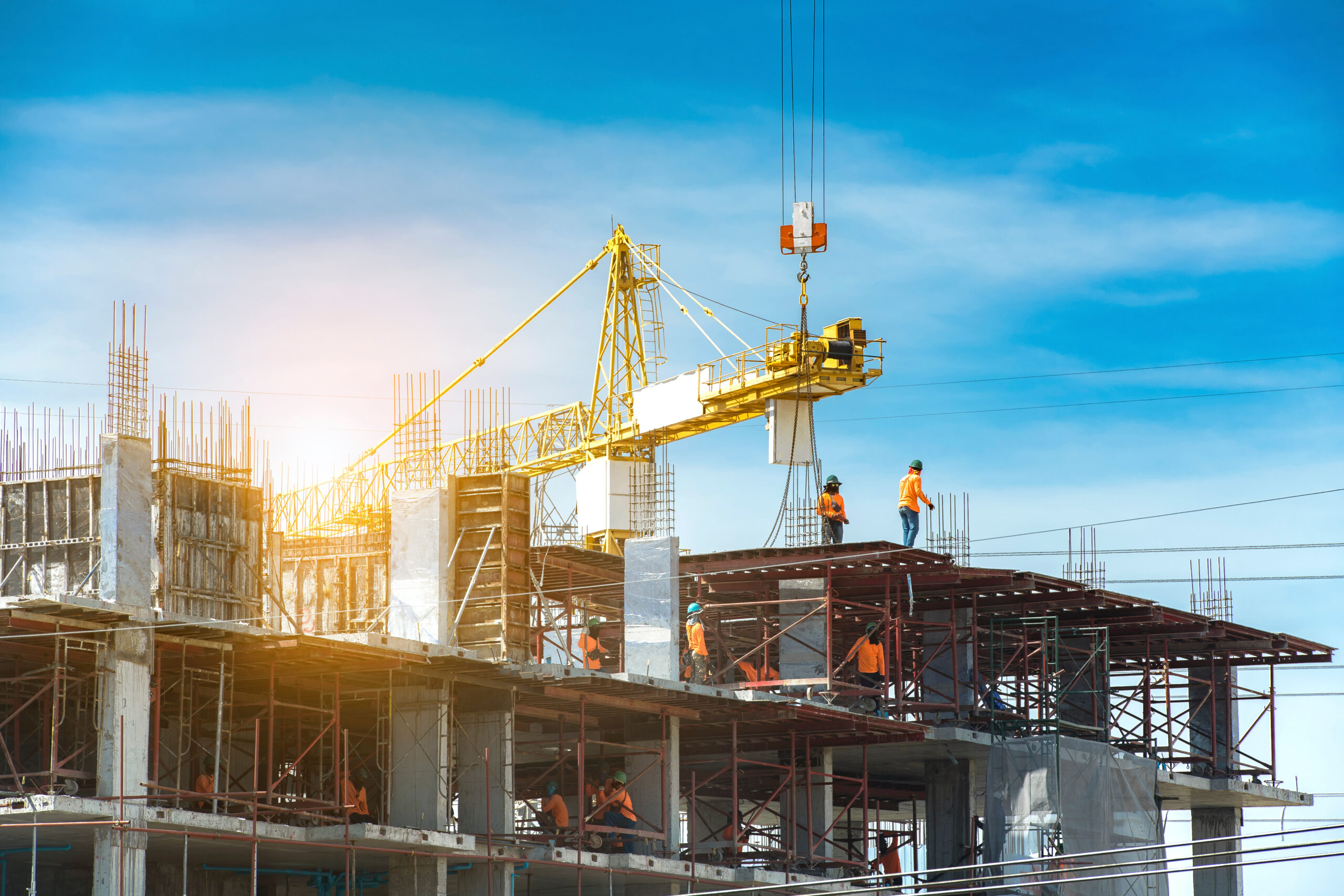
National Green Codes Pave the Way for Embodied Carbon Reporting
Post / December 4, 2023
The carbon footprint of a building starts at its inception, not when its occupants move in. Products like concrete, steel, aluminum, and insulation are key building components, but until recently were rarely considered by design and construction teams for their...

2024 IECC proposals address energy use in budding industry
Post / February 14, 2022
With the rapid growth of new indoor agriculture facilities growing vegetables, cannabis and other plants, the increased demand for energy and carbon intensive lighting and dehumidification for plant growth has skyrocketed. Lighting can consume between 50-70% of an indoor grow...

Proposals to drastically cut GHG delivered to IECC committees
Post / October 13, 2021
This week, New Buildings Institute (NBI) submitted code change proposals to the International Energy Conservation Code (IECC) residential and commercial development committees. These proposals have the potential to drastically reduce greenhouse gas (GHG) emissions from the building sector and help...

Codes for Loads – Making Our Buildings Work with Renewable Power Grids
Post / July 22, 2021
Thirty states and the District of Columbia have adopted Renewable Portfolio Standards (RPS), policies that require or set goals for all energy supply to be renewable by a chosen date mostly within the next two decades. The Biden Administration earlier...
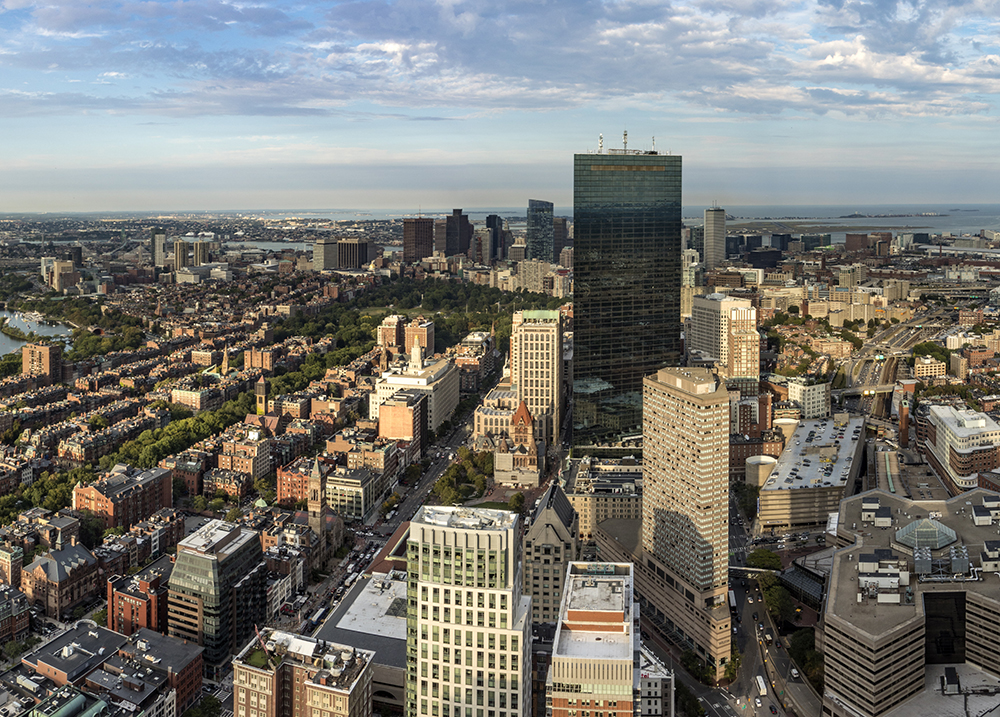
Stretch Codes: A Key Tool on the Path to Carbon Neutral Buildings
Post / December 16, 2020
Adopting energy codes that go beyond the base, or required minimum code, is proving to be an effective way to achieve energy savings and reduce carbon emission from the built environment. We have long been hearing about states such as...

Reduce Carbon in Existing Buildings and Put America Back to Work
Post / October 28, 2020
We all know too well of the health and economic impacts of the COVID-19 pandemic. These impacts are compounded by increasingly destructive wildfires, hurricanes, and flooding – so much so that nearly two-thirds of Americans – including more than half...

Implementing Building Performance Standards: Consistency is Key
Post / September 29, 2020
A building performance standard (BPS) provides a powerful solution for cities working to meet climate goals, achieve energy savings and reduce greenhouse gas (GHG) emissions. As a forward-looking policy for existing buildings, a BPS commits a city or state to...

Does the changing policy landscape pit efficiency against renewables?
Post / September 24, 2020
With cities and states pursing renewable portfolio standards and national calls to decarbonize the grid by 2035, does efficiency still matter with a clean grid? The first answer: yes, energy efficiency benefits are, as they have been for decades, delivering...
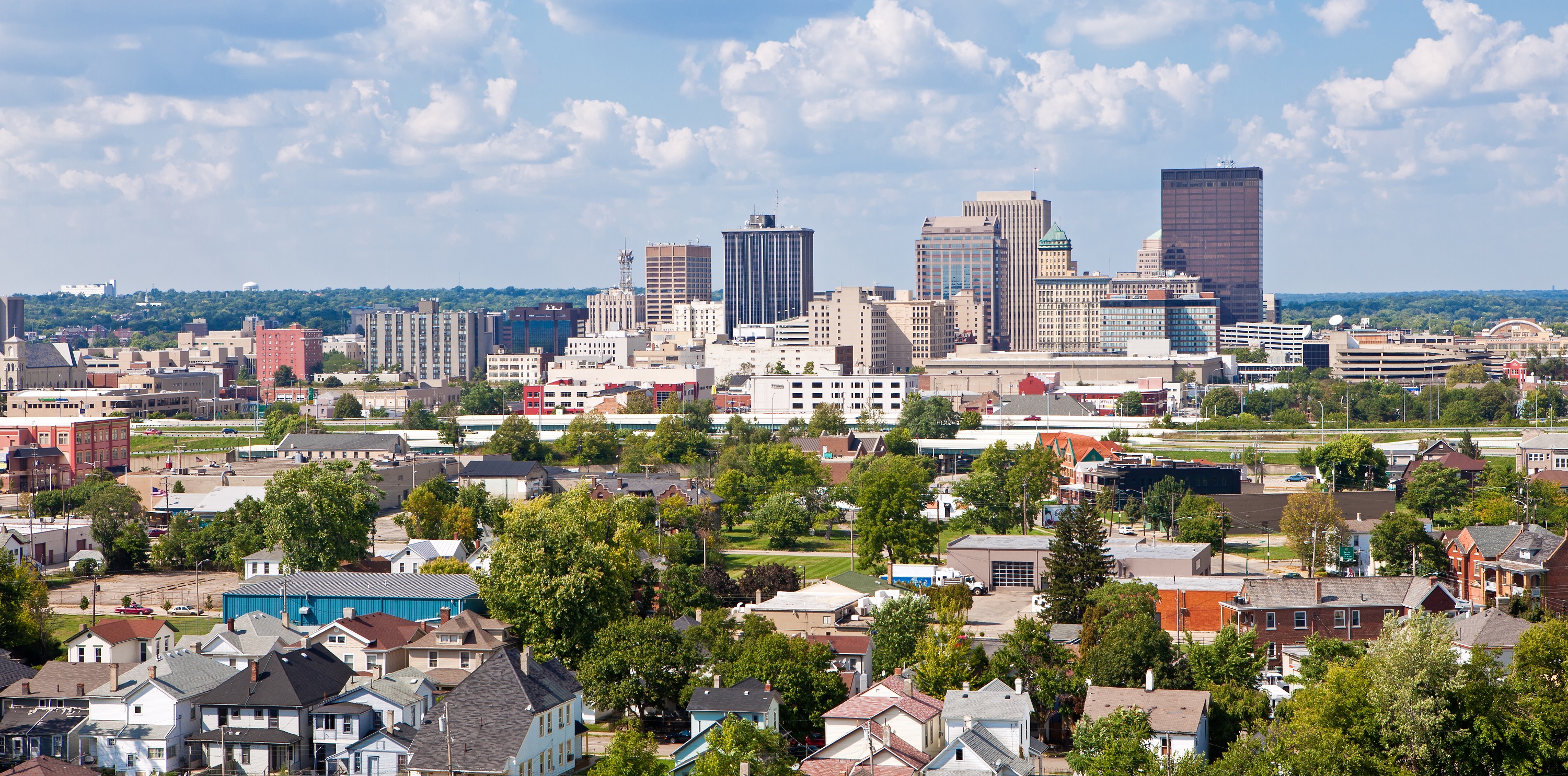
2021 Energy Code Progress Challenged: Climate and Affordability Stand to Lose Unless We Speak Up
Post / July 28, 2020
Update: See final result In December 2019, more than 1,000 government representatives from cities and states across the U.S. did something remarkable when they voted to improve the 2021 International Energy Conservation Code (IECC) by 10%. Since buildings account for...
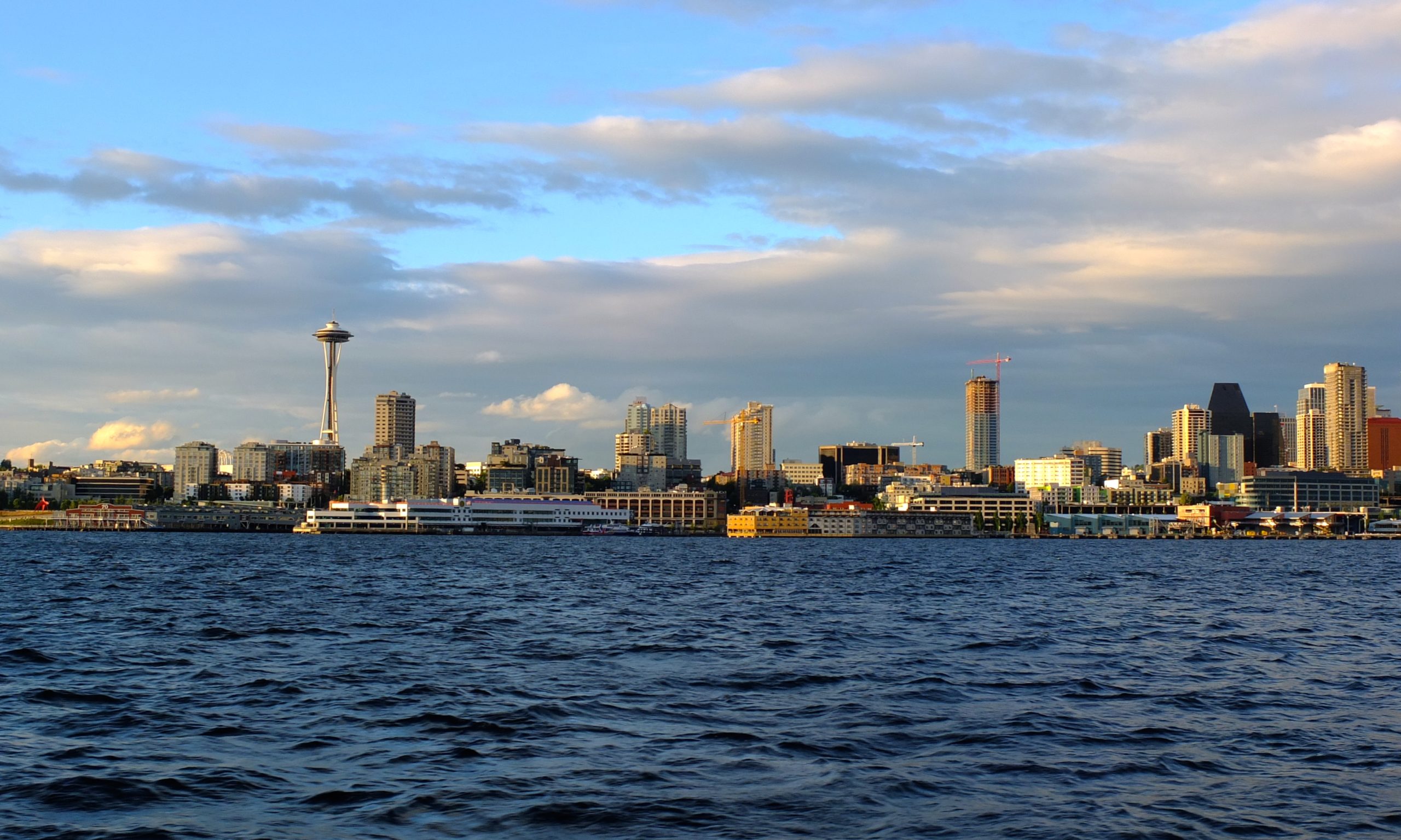
Delivering Climate Solutions From Existing Buildings: No Time to Waste
Post / July 13, 2020
With buildings accounting for up to 75% of carbon emissions in U.S. cities, addressing carbon emissions from the built environment is essential to meet the goals of the Paris Agreement and limit the rise in global average temperature to below...
Improved Building Energy Model Code Challenged
Post / March 12, 2020 / Energy Codes
Update: See final result Better building codes mean lower energy bills, which results in lower costs for consumers and fewer carbon emissions for the planet. Sounds like a winning combination, right? That’s why we were delighted when the initial results...
2019 was the Year of Energy Codes and a Big Year for Efficiency
Post / January 7, 2020
At the beginning of last year, we predicted that 2019 would be a big year for building energy codes, and the results are extremely promising for states—and cities which control their own energy codes–that are working to achieve climate action...
Before December 6, Vote for Efficiency in the 2021 IECC
Post / November 20, 2019
After a lengthy stakeholder process, including recent public comment hearings in Las Vegas, registered voting members of the International Code Council (ICC) are now invited to weigh in on the 2021 International Energy Conservation Code (IECC) proposals. Updated every three...
Tips for Voters In the 2021 IECC Update
Post / November 8, 2019
The 2021 International Energy Conservation Code voting dates are set! Voting begins on Tuesday, Nov. 19 and ends on Friday, Dec. 6. If you are a Governmental Member Voting Representative (GMVR), please read through these tips to help ensure it...
Votes Matter for Better Buildings
Post / October 31, 2019 / Energy Codes
Building code officials, sustainability officers, builders, efficiency advocates and others are leaving Las Vegas after attending the International Code Council’s (ICC) annual conference and public comment hearings on the 2021 International Energy Conservation Code (IECC). Updated every three years, the...
A Must Read: Landreneau’s Roadmap for Cleaner, Stronger Buildings that Help Solve the Climate Crisis
Post / October 30, 2019
Reducing carbon pollution and improving resilience in residential and commercial buildings across the United States was the topic of a House Select Committee hearing on the climate crisis last month. The hearing, “Solving the Climate Crisis: Cleaner, Stronger Buildings,” featured...

NBI Helps Decision Makers Prepare for the 2021 International Energy Conservation Code (IECC) Update
Post / October 23, 2019
The 2021 International Energy Conservation Code (IECC) update is one of the most profound ways states and local governments can improve the comfort and health of residents, reduce costs for building owners and residents, and make progress toward climate action...
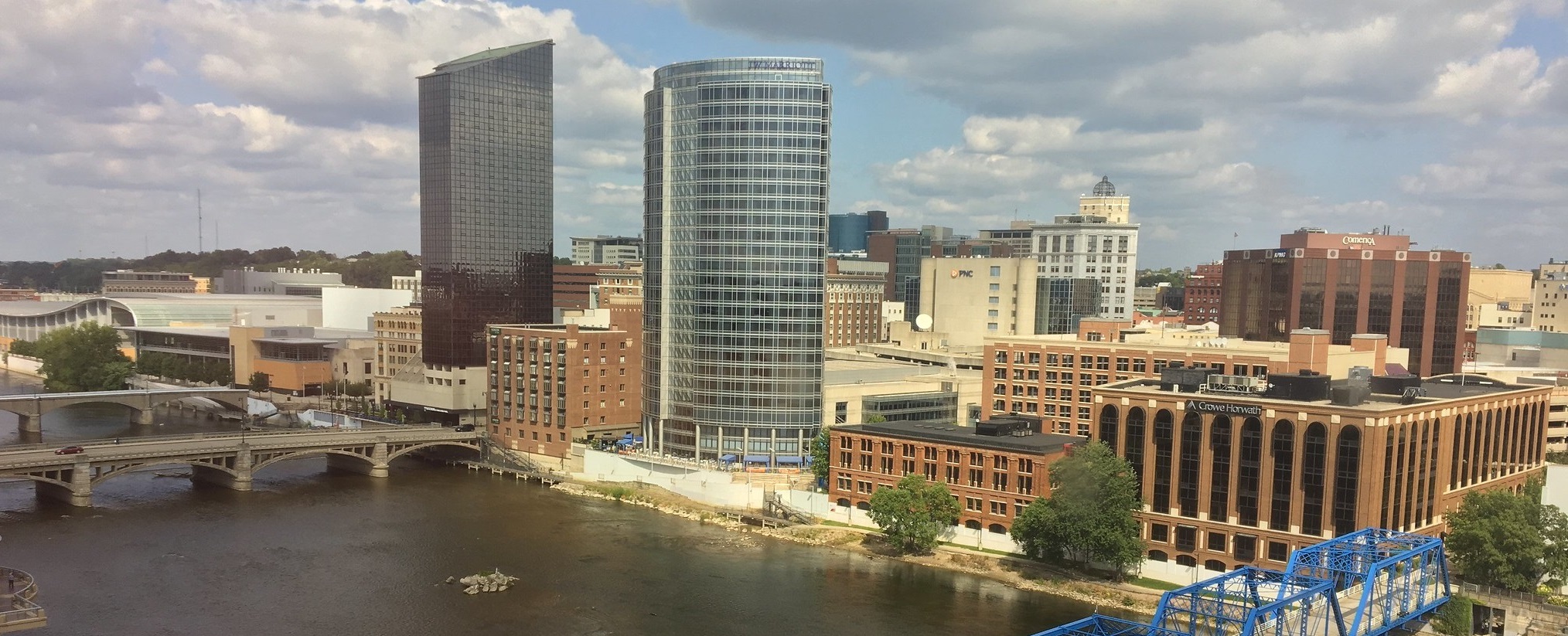
Public Buildings Portfolio Management Helps Cities Get on Track to Meet Climate Goals
Post / September 16, 2019
Hundreds of cities across the country have set bold, aggressive energy and climate goals. Yet most of these communities are not on track to meet their goals, according to the latest City Clean Energy Scorecard, released in July by American...
Is Your City and State Ready to Vote on the 2021 International Energy Conservation Code?
Post / August 22, 2019
State and local government representatives have the power to advance local energy codes and improve the comfort and health of residents by participating in and voting for efficiency proposals in the 2021 International Energy Conservation Code (IECC) update. But they...
U.S. Conference of Mayors Unanimously Resolves to Support Advancements to the 2021 International Energy Conservation Code (IECC)
Post / August 16, 2019
The U.S. Conference of Mayors (USCM) is known for tackling issues of national importance. Climate change is one of those critical issues that the mayors addressed at their 2019 annual meeting in Honolulu, Hawaii. On July 1, 2019, the USCM...
Making the Transition From Zero Energy to Zero Carbon Building Policies
Post / July 23, 2019 / Zero Net Energy (ZNE)
As the building industry transitions into a new era — one focused on delivering carbon-neutral buildings — building codes will continue to play a critical role. This is the third in a series of blog posts about the transformation occurring within...

Decarbonizing Buildings: A Changing Lexicon
Post / June 12, 2019
From kilowatts to carbon, the language we use matters. Building sector policies and programs across the nation are in the midst of a critical shift from delivering energy efficiency in terms of kWh, to policies and programs that seek carbon...

Key Takeaways From Recent IECC Code Development Hearings
Post / June 10, 2019
Code officials, architects, builders, engineers and energy conservation professionals gathered last month in Albuquerque for the International Energy Conservation Code (IECC)’s Committee Action Hearings. The proceedings were the first step in a lengthy stakeholder process to update the 2021 IECC,...
Efficiency and Carbon Reduction Goals Converge at the Built Environment
Post / April 17, 2019
With mounting evidence that immediate and aggressive action is necessary to address climate change, combined with a lack of leadership on this issue by the federal government, state and local governments are taking meaningful actions to adopt, honor, and meet...
A Small Window of Opportunity to Make Huge Gains in Climate Action
Post / March 19, 2019
Cities face unrelenting demands on policy priorities. Affordable housing, transportation, economic development, climate action, and other pressing issues compete for limited resources and funds. Now is a moment in time, however, when the opportunity to make significant progress toward carbon...
2019 is the Year of Energy Codes
Post / January 14, 2019
If there’s a defining theme for the building sector in 2019, it’s energy codes. Actions to update the rules that cities and states set to determine how effectively new residential and commercial buildings use energy are progressing on several fronts...
Four States Make Strides on Advancing Energy Codes
Post / December 5, 2018
Massachusetts, California and Rhode Island come out on top in the 2018 State Energy Efficiency Scorecard released this fall. The three states ranked high on six categories including utility programs, transportation, building energy codes, combined heat and power, state initiative and...
Michigan Is the Latest State to Embrace the Value of Clean Energy Portfolios
Post / May 23, 2018
This guest blog was originally published by Rocky Mountain Institute on May 22, 2018. How renewable energy can unlock customer savings and shareholder value in the Midwest Last Friday, Michigan’s two largest electric utilities, DTE Energy and Consumers Energy, announced...
NBI’s Legacy of Code Advocacy Lives On
Post / March 8, 2018 / Energy Codes
New Buildings Institute (NBI) has played an active and influential role in building energy codes since the day its doors opened in 1997. Jeff Johnson, one of its first executive directors, was an ardent codes advocate with a long track...
Outcomes Matter
Post / November 16, 2017 / Energy Codes
by Ryan M. Colker, Vice President of National Institute of Building Sciences We all know what it takes to lead a healthy life—eat your vegetables, exercise, and visit your doctor to monitor your cholesterol, blood sugar, weight and blood pressure....
Stretch Codes: A Disruptive Solution to Super Charge Green Building
Post / November 6, 2017 / Energy Codes
This week, thousands of building industry professionals will converge at Greenbuild 2017 to share their excitement and progress advancing green buildings. While the number of green buildings—energy-efficient, zero energy, LEED and ENERGY STAR-certified, etc.—has grown dramatically over the last decade,...

The Budding Energy Footprint of Indoor Agriculture
Post / April 7, 2017
Indoor agriculture energy usage is projected to grow substantially over the next several years, driven in large part (but not entirely) by the legalization of medical and recreational cannabis. Seven U.S. states and the District of Columbia have legalized recreational...
Energy Codes Must Evolve to Achieve Policy Goals
Post / September 23, 2015
Energy codes are anticipated to play a big role in the building performance targets adopted by many jurisdictions to reduce carbon impacts from the building sector. But as codes target deep efficiencies, conventional code language and enforcement mechanisms face significant...
Codes Make a Difference–A Big Difference
Post / April 6, 2015
Since its inception nearly 18 years ago, NBI has maintained a strong emphasis on energy codes. Current NBI staff and board members continue the focus established early on by the organization’s founders. We know codes make a difference—a big difference....
Vermont Leads the Way
Post / December 30, 2014
What do the State of Vermont and NBI have in common (besides a soft spot for counterculture energy nerds)? I’d answer that both are small in stature but have built legacies around aggressively pushing for codes and policies that promote...
2015 IgCC gives cities and states something to be thankful for
Post / November 25, 2014
As we move toward Thanksgiving this Thursday, the recent adoption of the 2015 International Green Construction Code (IgCC) gives cities and states a lot to be thankful for. Four critical proposals that will drive significant improvements in building energy performance...
The Energy Code Paradox
Post / September 17, 2014
What happens when compliance becomes a barrier to achieving energy performance in buildings? For over fifteen years, New Buildings Institute (NBI) has worked to advance energy codes in jurisdictions around North America. We’ve had some huge wins for higher efficiency...
Persuasive Communications and Building Codes
Post / August 6, 2014
NBI is deeply involved in energy code development in the commercial sector, including pursing an Outcome-Based Compliance Path for the 2015 IgCC. With more than half of U.S. states still with outdated building energy codes, employing the power of persuasive...
Getting serious about carbon emissions, EPA releases new proposal on clean power
Post / June 4, 2014
The U.S. Environmental Protection Agency (EPA) yesterday released its new Clean Power Plan proposal which is intended to cut carbon pollution from existing power plants–the single largest source of carbon pollution in the United States. New Buildings Institute (NBI) applauds...
Case StudiesView All
There are no case studies for Codes & Policies. Please see our other case studies below.
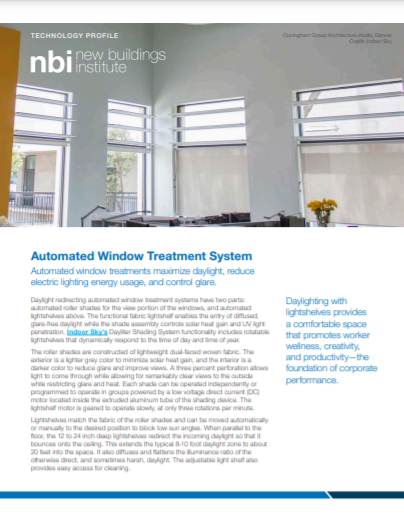
Automated Window Treatment Case Study
Case Study / June 1, 2021
Several manufacturers offer innovative window treatment solutions that allow daylight into spaces while controlling for glare and allowing views to the outdoors. In this case study, we focus on Indoor Sky’s Daylighter Shading System. The system has two parts: automated…
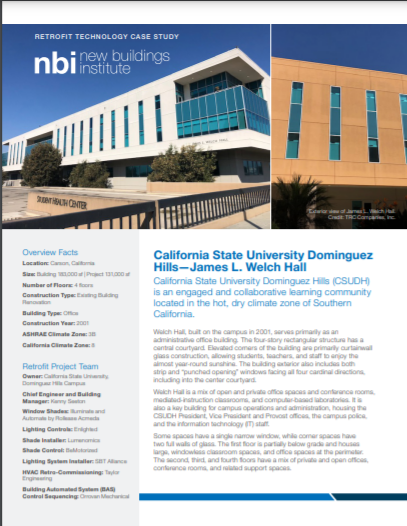
California State University Dominguez Hills—James L. Welch Hall
Case Study / June 1, 2021
The Welch Hall building on the CSUDH campus partnered with the project team to retrofit their existing Enlighted lighting system and manual shades to the INTER package – which included LED lighting with Luminaire-level lighting control (LLLC), solar-powered automated shades,…
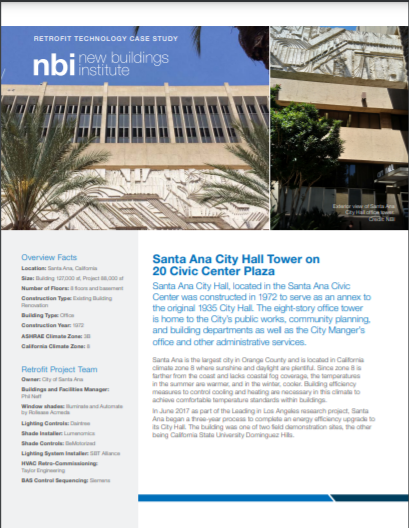
Santa Ana City Hall Tower on 20 Civic Center Plaza
Case Study / June 1, 2021
The City Hall building in Santa Ana sought to improve their indoor environment and save on energy costs with automated shades, upgraded lighting fixtures and networked lighting controls. The project updated the existing T8 lamps to LEDs and controlled the…
Ultra-Low Energy Campus Case Study: King Open/Cambridge Street Upper Schools and Community Complex Case Study
Case Study / July 20, 2020
In 2015 the Cambridge city council voted to adopt a Net Zero Action Plan, requiring all city buildings to target net zero energy design by 2020. When the City issued the request for proposals for the new King Open/Cambridge Street…
Emerging Zero Net Energy School Retrofit Case Study: Los Osos Middle School
Case Study / January 24, 2018
The mild climate in coastal cities such as Los Osos makes ZNE performance a realistic target with minimal needs for heating and cooling. It should however be noted that in such mild climates payback on upgrades to heating systems can…
Emerging Zero Net Energy School Retrofit Case Study: Newcastle Elementary School
Case Study / January 24, 2018
With funding from California’s Prop 39, the Newcastle Elementary School District (ESD) issued a request for proposal to develop an Energy Expenditure Plan for their district. With a long list of deferred maintenance issues and budget challenges, Newcastle ESD was…
Emerging Zero Net Energy School Retrofit Case Study: Garden Grove School District
Case Study / January 24, 2018
Garden Grove Unified School District (GGUSD) is a large, low-income school district that has recently become a regional leader in Zero Net Energy. Among California’s 140 school districts with greater than 65% for Free & Reduced Price Meals, GGUSD was…
Radiant Cooling and Heating Systems
Case Study / September 13, 2017 / HVAC
Several buildings with radiant heating and cooling systems were studied under a California Energy Commission EPIC research project in 2016-2017 and those case studies are available here. While forced-air distribution systems remain the predominant approach to heating and cooling in…
Verified ZNE Building Case Study: North Face & VF Outdoors
Case Study / March 8, 2017
The North Face corporate facility is part of the VF Outdoor Campus in Alameda, California. The VF Outdoors Headquarters occupies 14 acres of the Harbor Business Park and includes a 160,000-square-foot, four-building development completed in 2012. A fifth building is…
Emerging ZNE Building Case Study: Environmental Innovation Center
Case Study / March 8, 2017
Completed in 2014, the Environmental Innovation Center (EIC) in San José, CA, is a local government-owned education and environmental resources center that is targeting zero net energy (ZNE) performance. The project contains a 10,000-square-foot new building and a retrofit of…
Emerging ZNE Building Case Study: California State Lottery District Office in Santa Fe Springs
Case Study / March 8, 2017
The California State Lottery District Office in Santa Fe Springs is a retrofit of an existing 12,840-square-foot warehouse and is one of the first state-owned and operated buildings to target zero net energy (ZNE). The Lottery partnered with LPAS Architecture…
Verified ZNE Building Case Study: Bagatelos Architectural Glass Systems Manufacturing Facility
Case Study / March 8, 2017
The Bagatelos Architectural Glass Systems (BAGS) manufacturing facility is a retrofit of a 1969 concrete warehouse that was renovated in 2008 to be a zero net energy (ZNE) building. The 63,000-square-foot Bagatelos Architectural Glass Systems manufacturing facility produces custom glass…
Verified ZNE Building Case Study: 435 Indio Way
Case Study / March 8, 2017
435 Indio Way in Sunnyvale, California, was built in 1973 as a research and development laboratory and office for Hewlett Packard. Like many buildings in the Silicon Valley, it is a simple one-story, tilt-up that since 2006 had been left…
Ultra-Low Energy School Case Study: Jeffrey Trail Middle School
Case Study / December 13, 2016
The Jeffrey Trail Middle School is a new school in the Irvine Unified School District (IUSD). The school was designed and constructed to meet the Collaborative for High Performance Schools (CHPS) performance standards for exemplary energy and water conservation. With…
Ultra-Low Energy School Case Study: Georgina Blach Intermediate School
Case Study / December 13, 2016
The Georgina Blach Intermediate School, part of the Los Altos School District, Iocated in Los Altos, California, serves 450 students in seventh and eighth grades. Facilities at the school were unimproved since their construction in 1958, 1962-63 and 1978 and…
Emerging ZNE School Case Study: George V. LeyVa Middle School Administration Building
Case Study / December 13, 2016
The George V. LeyVa Middle School Administration Building was designed to be one of the first zero net energy (ZNE) public school buildings in California as well as the first zero net emissions public school building in California. This leading…
Verified ZNE Case Study: West Berkeley Public Library
Case Study / December 13, 2016
The West Berkeley Public Library is the first verified zero net energy (ZNE) public library in California. Completed in late 2013, the 9,400-square-foot library produces as much or more energy than it consumes on an annual basis. To reach its…
Ultra-Low Energy School Case Study: San Francisco City College Multi-Use Building
Case Study / December 13, 2016
The San Francisco City College Multi-Use Building is a pioneering project for large, low-energy facilities. At 102,000 square feet, the building is one of the largest in the United States to rely nearly entirely on natural ventilation to meet fresh…
Verified ZNE Multifamily Case Study: zHome Multifamily Complex
Case Study / October 10, 2016
The zHome multifamily complex was the first zero net energy project of its kind in the United States. This complex is made up of 10 units and a shared community area. The design approach of the project centered on energy…
Verified ZNE Portfolio Case Study: Gundersen Health System
Case Study / October 10, 2016
Gundersen Health System is the largest portfolio of buildings striving to reach zero net energy performance on a district wide scale in North America. The portfolio is made up of 45 new and existing buildings and spanning more than 2.5…
Savings Verification for Performance Contracting
Case Study / December 23, 2015
Washington’s Department of General Administration supervised an energy system retrofit of Spokane’s Westlake State Hospital and then was responsible for verifying the energy savings resulting from the improvements. However, when the hospital’s energy management system experienced a partial loss of…
The Runaway Building
Case Study / December 23, 2015
EZ Sim showed its versatility and its accuracy when analyzing a building with run away winter energy bills. While the building was initially modeled using a traditional engineering method, EZ Sim provided a quicker alternative to identify the nature of…
EZ SIM – Shows Bonus Energy Savings for County Office Building
Case Study / December 23, 2015
When a county building’s facility manager wanted to know if it was time to upgrade the building’s heat pumps, EZ Sim’s detective work helped to uncover more savings in more places than she bargained.
New England Regional Council of Carpenters
Case Study / December 23, 2015
The New England Regional Council of Carpenters (NERCC) represents 22,000 carpenters, pile drivers, shop and mill men, and floorcoverers working in the New England states.
Gibney Family Vision Center
Case Study / December 23, 2015
The Vermont Association for the Blind and Visually Impaired (VABVI), a non-profit organization founded in 1926, is the only private rehabilitation agency to offer free training, services and support to visually impaired Vermonters of all ages. VABVI offices are located…
Fidelity Bank
Case Study / December 23, 2015
Fidelity Bank is one of the oldest and continually growing independent, local community banks in Central Massachusetts. In January 2007, the bank opened its new Corporate Center and Branch in Leominster, Massachusetts. The four-story building includes office space as well…
Duxbury Bay Maritime School
Case Study / December 23, 2015
Serving more than 1,800 students annually, the not-for-profit Duxbury Bay Maritime School aims to connect the community through educational and recreational programs with its primary resource, Duxbury Bay.
Child and Family of Newport County
Case Study / December 23, 2015
Child and Family of Newport County (CF) is a nonprofit organization dedicated to strengthening families and communities through services such as preschool childcare, counseling, home care for the elderly and disabled, substance abuse education, home-based child welfare, transitional housing for…
Abraham Lincoln Elementary School
Case Study / December 23, 2015
In September 2010, the Abraham Lincoln Elementary School opened its new green building, ready to accommodate 600 students. This new building includes masonry and steel construction, a 3,300 square foot state-of-the-art library and media center, a 5,700 square foot gymnasium,…
New Construction Project Directory & Case Studies
Case Study / December 23, 2015
Information about New Construction projects that have utilized Core Performance are available here and, when available, include links to case studies or project profiles.
Emerging ZNE K-12 School: Turkey Foot Middle School
Case Study / December 19, 2015
The Kenton County School District believes “schools should use less energy, demonstrate sound environmental practices and serve as a fundamental tool for learning.” Since the District had experience with a formal energy management program that saved over $2 million since…
Ultra-Low Energy Building: The Ramona
Case Study / December 19, 2015
The Ramona is a mixed-use development in the urban Pearl District of Portland, Oregon. The building hosts 138 units of affordable housing and two educational facilities. Portland Public Schools rents 13,000 SF for programs for children ages 3 to 6.…
Verified ZNE Retail Bank Branch: TD Bank
Case Study / December 19, 2015
TD Bank has been an environmental leader since 1990. As one of the ten largest banks in the United States, they chose to move beyond LEED certification to pilot a Zero Net Energy design for a retail bank branch in…
Emerging ZNE K-12 School: Dr. David Suzuki Public School
Case Study / December 19, 2015
The Dr. David Suzuki Public School combines readily available and demonstration technologies to create a school building that serves as a living laboratory for 550 students in Windsor, Ontario. The two-story kindergarten through 8th grade school includes classrooms, a gymnasium,…
Emerging ZNE Building: Rice Fergus Miller Office and Studio
Case Study / December 19, 2015
Rice Fergus Miller breathed new life into an abandoned 1948 Sears Automotive Center and positioned their new office solidly on the path to net zero. This urban infill transformation project took a dilapidated structure that had been abandoned for 23…
Verified ZNE School: Putney Field House
Case Study / December 19, 2015
The Putney Field House is located on a 461-acre parcel, with areas dedicated to forestry, education and agriculture. The site includes indigenous plantings and a production garden. The state-of-the art field house and wellness center was built to provide winter…
Verified ZNE Building: Leon County Cooperative Extension Office Building
Case Study / December 19, 2015
The mission of the Leon County Cooperative Extension is to educate the community about research performed at the University of Florida through interactive opportunities and demonstration sites. A recent retrofit of their 13,000 SF office was the perfect opportunity to…
Verified ZNE District: Anna Maria Historic Green Village
Case Study / December 19, 2015
The Anna Maria Historic Green Village is an unusual combination of historic restoration and modern technology. Owners Mike and Lizzie Thrasher have worked diligently to preserve four 100-year old buildings and merge history with state-of-the-art green technology, all while bringing…
Emerging ZNE Museum: Exploratorium
Case Study / December 19, 2015
When the Exploratorium outgrew its old location at the Palace of Fine Arts, the City of San Francisco offered to provide Piers 15 and 17 on its historic waterfront as a larger relocation option for the science museum. After structurally…
Verified ZNE Small Office Retrofit: Bacon Street Offices
Case Study / December 19, 2015
The Bacon Street Office project is a 4,500 SF retrofit of a single-story, 1950’s-era auto repair shop into a high performance office for the firm ARCHITECTS hannah gabriel wells. Through creative design strategies, renewable energy generation and with support from…
Verified ZNE Training Center: Zero Net Energy Center
Case Study / December 19, 2015
When it came time to upgrade their training facility, the IBEW Local 595 and NECA chapters targeted net zero energy. They wanted to demonstrate that this goal was achievable and train their electrical contractors on the latest, cutting-edge energy efficiency…
Verified ZNE Office: David and Lucile Packard Foundation
Case Study / December 19, 2015
When the Packard Foundation started thinking about building a new headquarters, they wanted to make sure the final product reflected the organization’s values. These include conserving the Earth’s natural resources over the long-term, providing a comfortable and healthy space that…
Ultra-Low Energy High Rise Office: The San Francisco Public Utilities Commission (SFPUC) Headquarters
Case Study / December 19, 2015 / Existing Buildings
The San Francisco Public Utilities Commission (SFPUC) headquarters is an ultralow-energy, Class A office building that pushes the norm in sustainable design. Located in downtown San Francisco, the 13-story building houses more than 900 employees who were previously located in…
Ultra-Low Energy Multifamily Residence: La Valentina North Townhomes
Case Study / December 19, 2015 / Existing Buildings
The La Valentine North Townhome project is the result of a partnership between SMUD and the owner/developer of the project, Domus Development LLC. The 18-unit affordable multifamily development is a research and demonstration project in SMUD’s Townhouse Home of the…
Verified ZNE K-12 School: Redding School for the Arts
Case Study / December 19, 2015 / Existing Buildings
Redding School for the Arts in Northern California connects education and arts for K-8 students in a community of 90,000 people. The school was originally created in August 1999 in response to the rapid decline of arts programs in local…
Verified ZNE Small Office Retrofit: DPR Construction
Case Study / December 19, 2015 / Existing Buildings
Acting as owner, designer and contractor, DPR rehabbed a near-obsolete, 1984 building into a vibrant, zero-net energy multi-tenant office. DPR’s new 24,000 SF tenant improvement includes an open office space along with 11 conference rooms, a large gathering area and…
StopWaste
Case Study / June 6, 2012
In March 2007, 31 staff at StopWaste.Org moved into a renovated building in downtown Oakland, California. Their goal was to transform a dilapidated, 14,000 SF, two-story structure into an attractive and environmentally responsible building. Built in 1926, the building is…
Case Studies of Applications for FirstView Software
Case Study / May 21, 2012
Several organizations and companies have utilized the FirstView™ software to analyze building energy performance. Some have relied on FirstView software for diagnostics to lead them to potential areas for improvement, while others have used FirstView software as a way to…
FirstView and USGBC Building Performance
Case Study / May 18, 2012
NBI's FirstView™ software and services have been used on over 200 LEED buildings involved in the U.S. Green Building Council’s Building Performance Partnership (BPP). BPP is a voluntary program designed to improve the performance of green buildings by providing a…
Joseph Vance Building
Case Study / April 27, 2012
Since its acquisition, significant investments have been made to renovate this building in Seattle to improve energy efficiency and environmental performance, as well as tenant experience. Occupancy increased from 68% to 96% and has seen increased rents, tenant retention and…
Lovejoy Building Case Study
Case Study / April 27, 2012
In Portland, OR a retrofit of the existing load-bearing brick structure required a major seismic upgrade in this building. The architects used this as an opportunity for an integrated response to advanced structural upgrades, enhanced user thermal comfort and improved…
Johnson Braund Design Group Case Study
Case Study / April 27, 2012
Johnson Braund Design Group (JBDG) in Seattle was able to dramatically improve their building’s energy performance, reduce operating costs and provide a test ground for energy-efficient design strategies to influence its clients. The JBDG Building now uses 69% less energy…
Christman Building Case Study
Case Study / April 27, 2012
The Christman in Lansing, MI is one of the few Triple LEED Platinum buildings designated by the USGBC LEED Program. The building is located in a climate zone comparable to Montana, northeast Washington and eastern Idaho, and its age and…
Aventine Case Study
Case Study / April 27, 2012
The Aventine in LaJolla, CA is a certified LEED Existing Building Platinum and has an Energy Star rating of 100, the highest possible, and uses just 23 kBtus/sf, 75% less than the national average for offices. Retrofits addressed high-energy loads…
1525 Wilson Boulevard
Case Study / April 27, 2012
This all-electric building in Rossyln, VA used a combination of energy efficiency strategies, including replacing HVAC and lighting systems and providing tenant education. Energy use was reduced by 35% in just one year, resulting in savings over $250,000 on energy…
Mercy Corps Headquarters
Case Study / April 27, 2012
This building in Portland, OR is 50% historic renovation and 50% new construction. The information in this profile addresses both the renovated and the new parts of the building. Pursuing energy efficiency supports their mission of sustainability, and lower operating…
Home On The Range
Case Study / April 27, 2012
This Project Profile builds on a case study prepared by USGBC, including data on energy performance for one year, and provides updated owner feedback and energy use data. The actual energy use of the building in Billings, MT, is 46…
Beardmore Building
Case Study / April 27, 2012
The Beardmore in Priest River, Idaho has the distinction of being one of the few buildings in the country that is both LEED Gold certified and on the National Register of Historic Places. The project demonstrates a very successful renovation…
200 Market Building
Case Study / April 27, 2012
The 200 Market building in Portland, OR, has made continuous energy retrofits and system improvements. These efforts have moved the building from an ENERGY STAR score of 79 in 2006 to a score of 98 (out of 100) in 2010,…
Alliance Center
Case Study / April 27, 2012
The Alliance for Sustainable Colorado launched a project titled “Modeling a Net Zero Future: Energy Efficiency in Existing Buildings” to explore options that will enable it to approach a zero-net energy goal. Several documents developed for the project are referenced…
Verified Zero Energy Building: IDeAs Z2 Design Facility
Case Study / April 26, 2012
IDeAs’ new headquarters in San Jose, CA was designed to meet 100% of its net energy requirements using renewable energy from photovoltaics.
A Zero Energy-Capable Building: Jane D’Aza Convent, House of Formation
Case Study / April 25, 2012
This series of smaller buildings in San Rafael, CA reflects a contemporary vision that includes a strong commitment to environmental responsibility.
Ultra-Low Energy Building: Doyle Conservation Center
Case Study / April 25, 2012
This training facility showcases the organization’s conservation activities. The LEED Gold rating reflects the mission of the Trustees of Reservations, which is “To preserve for public use and enjoyment, properties of exceptional scenic, historic, and ecological value in Massachusetts.”
Ultra-Low Energy School: Plano Elementary School
Case Study / April 25, 2012
Plano Elementary School serves 435 students in Warren County, Kentucky. The building includes 32 classrooms, 14 offices, six resource centers, media center, gym, server room, and cafeteria with kitchen. There are 20 public schools in this district and five of…
Ultra-Low Energy Building: Gilman Ordway Building at the Woods Hole Research Center
Case Study / April 25, 2012
In Falmouth, MA a 19th-century summer home is respectfully adapted with the addition of a contemporary office, laboratory, and common spaces. The integration of passive-solar and energy-conservation strategies, optimal performance, and onsite renewable power generation make this building 83% more…
A Zero Energy-Capable Building: Kirsch Center for Environmental Studies
Case Study / April 25, 2012
For this two-story building in Cupertino, CA the design process moved through six steps to responsibly approach carbon neutral operation and roughly track increasing cost effectiveness.
Verified Zero Energy Building: Omega Center for Sustainable Living
Case Study / April 25, 2012
Achieving net-zero energy required a design that eliminated waste and maximized the use of renewable energy resources. This building in Rhinebeck, NY is purposely compact, organized to harvest daylight, solar energy, and cooling breezes to reduce energy needs
A Zero Energy-Capable Building: Wampanoag Tribal Headquarters
Case Study / April 25, 2012
This building serves as an administrative, educational, and social center for the Wampanoag tribe, which has inhabited Martha’s Vineyard for hundreds of years. The design approach embodies the traditional Native American belief system of interdependence and respect for nature.
A Case For Deep Savings: 11 Case studies of Deep Energy Retrofits
Case Study / August 23, 2011
For NEEA’s BetterBricks program, New Buildings Institute investigated* 11 examples of energy retrofits in existing commercial buildings that, on average, use 50% less energy than the national average – most with an energy use intensity (EUI) of less than 40…
Measured Performance Case Study: Classroom & Office Building, UC Merced
Case Study / January 26, 2010
The Classroom and Office Building (COB) examined in this case study is one of five buildings in the initial phase of development at UC Merced. This case study examines the actual post-occupancy performance of COB in relation to design elements…
Measured Performance Case Study: Science & Engineering Building 1, UC Merced
Case Study / January 26, 2010
Science & Engineering (S&E) Building I is one of five buildings in the initial phase of development at UC Merced. This case study examines the actual post-occupancy energy performance of S&E in relation to design elements and objectives.
Tools & Guides
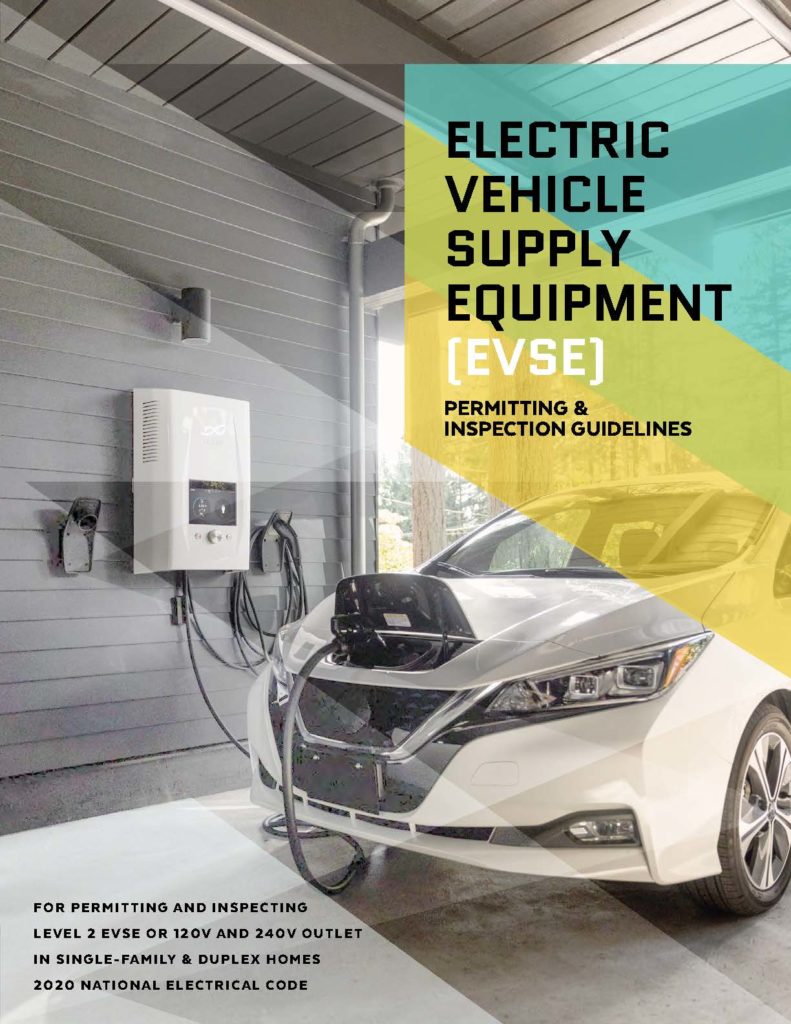
Electric Vehicle Supply Equipment, Energy Storage and Solar Permitting and Inspection Guidelines
Guideline / March 26, 2024
In many parts of the United States, navigating building permits required for distributed energy resources such as solar, storage, and electric vehicles (EVs) can be a daunting process. Under a three-year project funded by the Department of Energy, NBI has led…
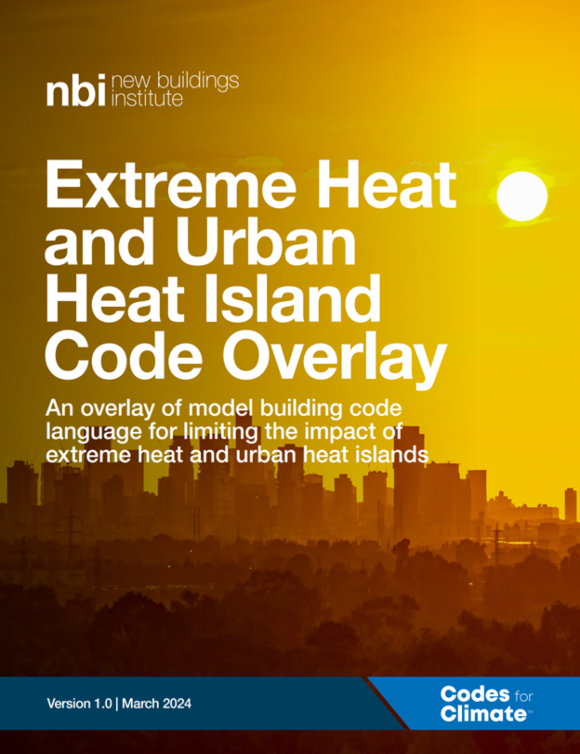
Extreme Heat and Urban Heat Island Code Overlay
Guideline / March 20, 2024
The Extreme Heat and Urban Heat Island Code Overlay provides code language for jurisdictions interested in acting against extreme heat and mitigating the urban heat island (UHI) effect. The Code Overlay strengthens and expands on cool surface requirements in model…

Embodied Carbon Building Code
Guideline / August 31, 2023
The Embodied Carbon Building Code overlay introduces code solutions incorporating prescriptive embodied carbon International Building Code (IBC) amendments for nearly 40 products, encompassing widely used and high carbon-emitting building materials. The overlay was created for policymakers seeking code language to…
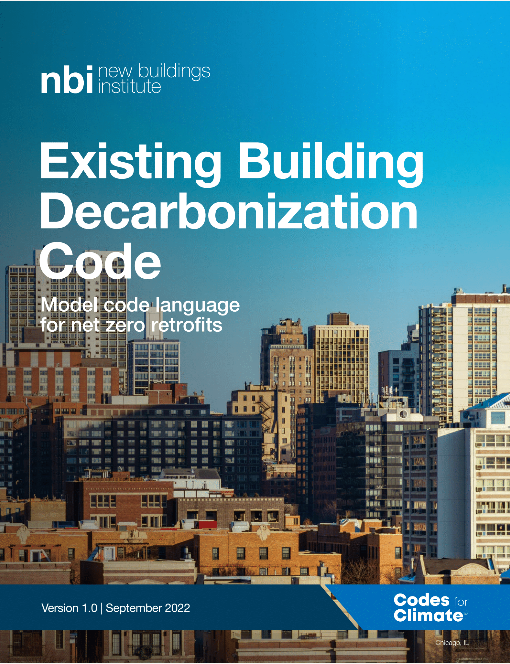
Existing Building Decarbonization Code
Guideline / September 19, 2022
The Existing Building Decarbonization Code is a new way for jurisdictions to reduce carbon emissions and meet Climate Action Plan and public health and equity goals. The need to address existing building stock is great, with 5.9 million existing commercial…
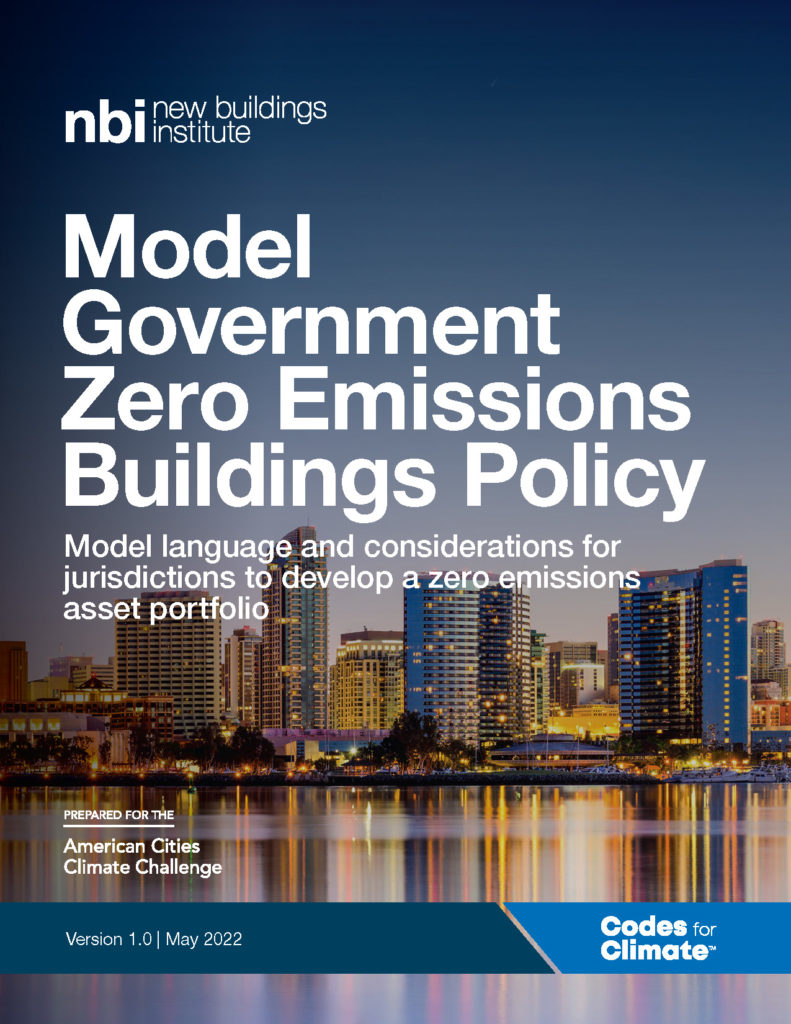
Model Government Zero Emissions Building Policy
Guideline / May 18, 2022
Released by New Buildings Institute, the Model Government Zero Emissions Buildings Policy provides plug-and-play policy language for jurisdictions considering taking a “lead by example” approach to building decarbonization. By using their own buildings to demonstrate how new technologies and operational…
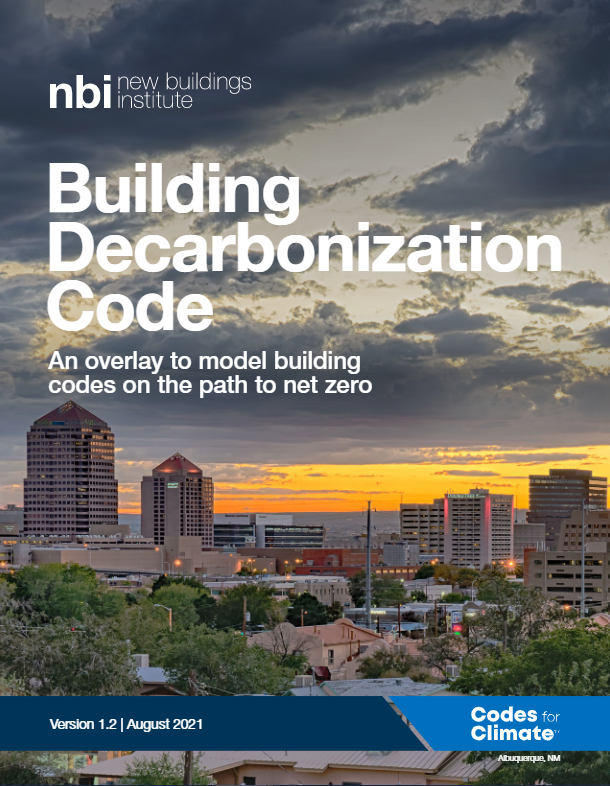
Building Decarbonization Code
Guideline / August 26, 2021 / Energy Codes
The Building Decarbonization Code is a groundbreaking tool aiming to deliver carbon neutral performance. The Version 1.2 code language from NBI serves as a building decarbonization overlay to the 2021 International Energy Conservation Code (IECC) and is now compatible with…
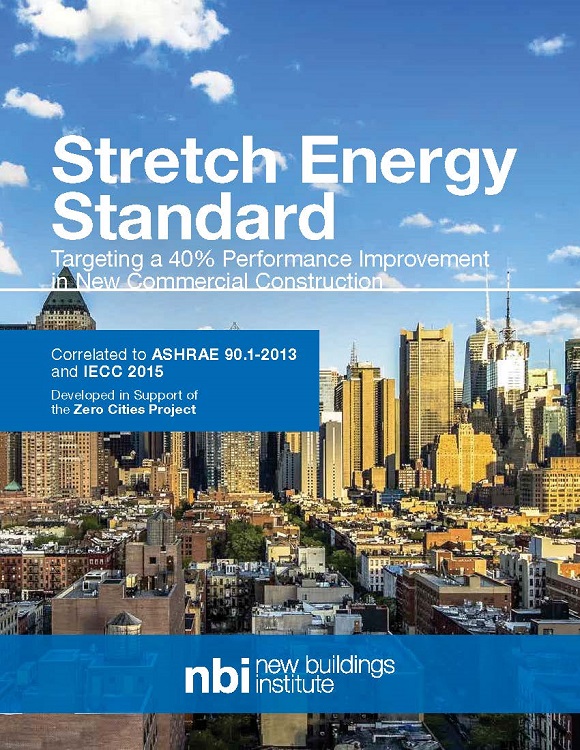
40% Stretch Energy Standard
Guideline / February 14, 2019
The 40% Stretch Energy Standard is a set of stretch code strategies that target 40% better efficiency in commercial buildings than current national model energy codes. Stretch codes, also called reach codes, provide an opportunity to introduce advanced practices in…
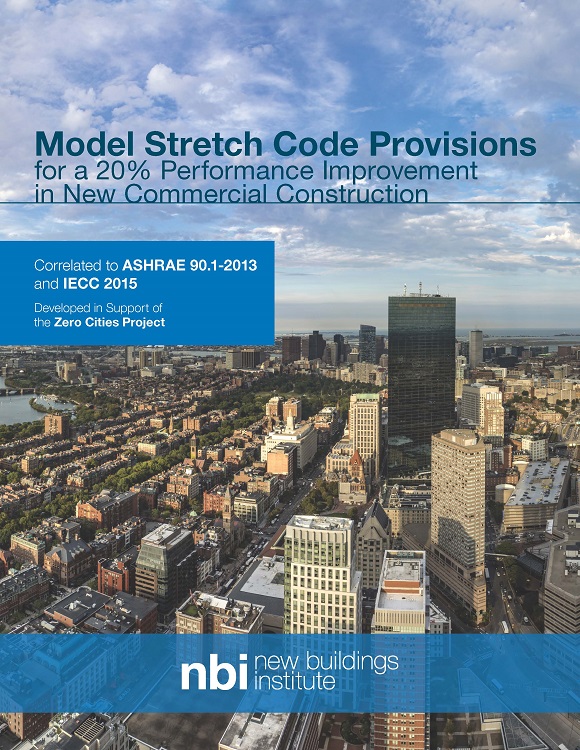
20% Stretch Code Provisions
Guideline / February 14, 2019
The 20% Stretch Code Provisions describe a set of code strategies that represent a 20% performance improvement for commercial buildings over the ASHRAE 90.1-2013 code baseline (and approximately similar savings over the IECC 2015 baseline) that can be adopted by…
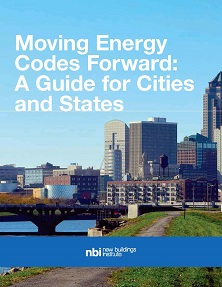
Moving Energy Codes Forward: A Guide for Cities and States
Guideline / June 4, 2018 / Energy Codes
In cities, the building sector is a major contributor to carbon emissions and energy use accounting for up to 40% of the total energy consumed. Some jurisdictions may have climate policies and climate action plans that set targets and lay…
Zero Energy Performance Index (zEPI) and zEPI Jurisdictional Scores
Online Tool / May 16, 2018 / Energy Codes
The Zero Energy Performance Index (zEPI) provides a scale for measuring commercial building energy performance and represents a fundamental shift in measurement of building efficiency as it sets energy targets for actual energy consumption rather than using a predictive energy…
Model Stretch Code Provisions for a 20% Performance Improvement in New Commercial Construction
Guideline / November 6, 2017 / Energy Codes
This summary document describes a set of code strategies that represent a 20% performance improvement for commercial buildings over the ASHRAE 90.1-2013 code baseline (and approximately similar savings over the IECC 2015 baseline).
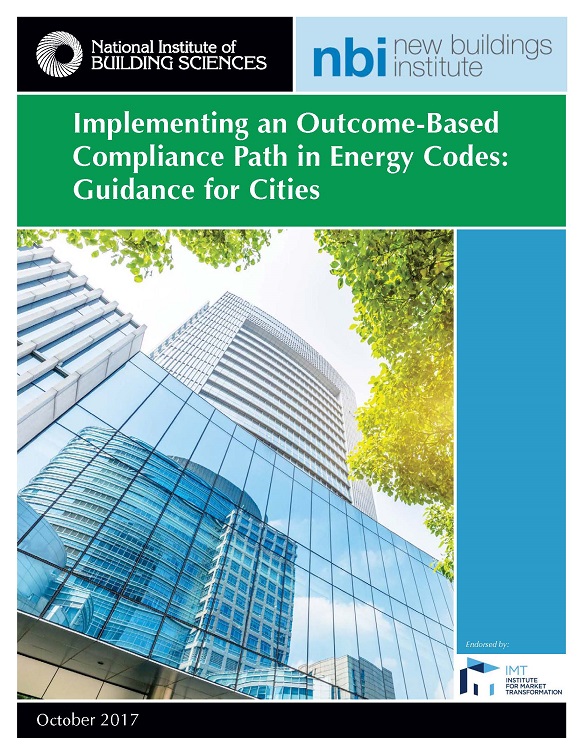
Outcome-Based Codes for Cities
Guideline / November 1, 2017
Adjustments and modifications to the built environment provide significant opportunities for meeting energy reduction goals and objectives, since buildings comprise 40% of our nation’s primary energy consumption. This document provides jurisdictions with a new approach to shift their focus towards…
COMNET
Guideline / December 19, 2015
COMNET is a quality assurance initiative to standardize building energy modeling, by creating consistent baselines relative to various energy codes and standards. COMNET extends and supports existing systems for assessing and rating the energy efficiency of new commercial and multifamily…
